Supply chain issues. A labor shortage. An increasingly competitive market: Can modular construction provide the relief developers seek?
By Dan Rafter, Editor
Developers face plenty of challenges today: It’s difficult to find experienced labor. Material costs keep rising. And supply chain disruptions mean that it can be difficult to get everything from insulation to concrete and steel to construction sites on time.
That’s why it’s not surprising to many commercial real es tate professionals that developers are slowly, but steadily, turning to modular construction when building restau rants, hotels, apartment projects and healthcare facilities.

Modular construction in the commercial development industry works much the same as it does with residen
tial projects: Anywhere from 60% to 90% of a building -- whether it be an apartment development, fast-food restaurant, hotel or school building -- is built offsite in a factory or manufacturing facility.
Building a stronger office market? Twin Cities CRE pros say pandemic challenges are resulting in better office space today
By Dan Rafter, Editor
o one disputes this: The COVID-19 pan demic hit the office sector as hard as any asset class – or even harder – in commer cial real estate.
But what does the future now hold for this still-strug gling sector? In the Twin Cities, at least, brokers work ing the office market say that this sector is starting to
show signs of a rebound, even as vacancy rates remain high.
But as the office market recovery continues, expect to see some pain. Not all office buildings in the Twin Cities and their suburbs will survive. Not all workers will return to the office on a full-time basis. And those companies that do want their employees to come back
might have to leave Class-B or -C space and seek new space in Class-A buildings.
The good news, though, is that these challenges are not insurmountable. And local CRE pros say that the future looks brighter for the office sector in the Twin Cities market.
©2022 Real Estate Publishing Corporation October 2022 • VOL. 38 NO. 4 Development Showcase: ALVERA Page 13 Development Showcase: Rya at RF64 Page 29
OFFICE (continued on page 8 N
CONSTRUCTION (continued on
page 11)
An example of a current modular project taking place in the Midwest is the Pentagon Village Apartments, a six-story, 202-unit apartment project planned for the Twin Cities suburb of Edina, Minnesota.





Let’s grow your business. econdev.greatriverenergy.com A STATE FULL OF RESOURCES. A FULL-SERVICE RESOURCE TEAM READY TO HELP. From data centers to agribusiness, our economic development team specializes in helping businesses start and expand here. Get started with our cost-free services:
SUPPLY CHAIN ISSUES. A LABOR SHORTAGE: CAN MODULAR CONSTRUCTION PROVIDE THE RELIEF DEVELOPERS SEEK? Developers face plenty of challenges today: It’s difficult to find experienced labor. Material costs keep rising. And supply chain disruptions continually throw schedules into disarray. It’s not surprising then that developers are slowly, but steadily, turning to modular construction.
BUILDING A STRONGER OFFICE MARKET? TWIN CITIES CRE PROS SAY PANDEMIC CHALLENGES ARE RESULTING IN A BETTER OFFICE SPACE TODAY: The COVID-19 pandemic hit the office sector as hard as any asset class – or even harder – in commercial real estate. But what does the future hold? In the Twin Cities, at least, brokers say that this sector is starting to show signs of a rebound, even as vacancy rates remain high.
PROPERTY MANAGERS A POWERFUL ALLY FOR OFFICE OWNERS TODAY: These are challenging times for the owners of office buildings, with the work-from-home movement leaving many office buildings across the country with far higher vacancy rates. There is an ally, though, that can help office building owners through these challenging times, property management firms.

DEVELOPMENT SHOWCASE: ALVERA
NO SIGN YET OF LAGGING MOMENTUM IN THE TWIN CITIES MULTIFAMILY MARKET: The momentum in the Twin Cities’ multifamily market isn’t slowing, even with higher interest rates and nagging inflation. Vacancies in apartment towers in downtown and campuses in the suburbs continue to fall. Demand is still outpacing the supply of available apartments. And investors still view apartments in the Twin City market as safe homes for their dollars.


DEVELOPMENT SHOWCASE: RYA AT RF64
WE LOVE OUR STUFF: INVESTOR INTEREST IN SELF-STORAGE SPACE STILL ON THE RISE: How much extra stuff do Americans bring into their homes each year? StorageCafe says that one in three Americans have so much that they need to rent self-storage units to hold it.
MOST NEW UNITS SINCE 1972: DEVELOPERS BUILDING APARTMENT UNITS AT A RECORD-SETTING PACE: A building boom. That’s what the U.S. apartment market is seeing this year, according to the latest research from Yardi Matrix.

3OCTOBER 2022 MINNESOTA REAL ESTATE JOURNAL
1 1 4 26 13 29 37 38 Minnesota Real Estate Journal (ISSN 08932255) Copyright © 2022 by the Minnesota Real Estate Journal is published bi-monthly for $85 a year by Jeff Johnson, 7767 Elm Creek Boulevard, Suite 210, Maple Grove, MN 55369. Monthly Business and Editorial Offices: 7767 Elm Creek Boulevard, Suite 210, Maple Grove, MN 55369 Accounting and Circulation Offices: Jeff Johnson, 7767 Elm Creek Boulevard, Suite 210, Maple Grove, MN 55369. Call 952-885-0815 to subscribe. For more information call: 952-885-0815. Periodical postage paid at Maple Grove and additional mailing offices. POSTMASTER: Send address changes to Minnesota Real Estate Journal, 7767 Elm Creek Boulevard, Suite 210, Maple Grove, MN 55369 ©2022 Real Estate Publishing Corporation. No part of this publication may be reproduced without the written permission of the publisher. OCTOBER 2022 MINNESOTA REAL ESTATE JOURNAL CONTENTS LOCATION ADVANTAGES • 15-minutes from the MSP International Airport • 10-minutes to downtown St. Paul with lots of land • 4-Hours to Madison & Des Moines, 6-Hours to Chicago • Centrally located within the US. Easy access to Canada and the rest of the United States WHY WASHINGTON COUNTY? CONTACT Christopher Eng Washington County CDA Director of Economic Development 7645 Currell Boulevard Woodbury, MN 55125 (651) 202-2814 ChrisE@washingtoncountycda.org For more information, visit www.EastMetroMSP.org
President
Publisher
Johnson jeff.johnson@rejournals.com
Managing Editor
Dan Rafter drafter@rejournals.com
Vice President | Publisher Jay Kodytek jay.kodytek@rejournals.com

Chief Financial Officer
Todd Phillips todd.phillips@rejournals.com
Art Director | Graphic Designer


Alan Davis alan.davis@rejournals.com
Managing Director National Events & Marketing Alyssa Gawlinski agawlinski@rejournals.com
Elm Creek Boulevard, Suite 210 Maple Grove, MN 55369
For information call 952-885-0815
ADVISORY BOARD JOHN ALLEN JEFF EATON MARK EVENSON
GNETZ
GUMP
JOHNSON
WARDWELL
Work-from-home? A flight to quality? Rising vacancies? Property managers can help office building owners navigate challenging times
By Dan Rafter, Editor
These are challenging times for the owners of office buildings. The workfrom-home movement has meant that many companies are moving to small er office spaces as more of their employees work remotely at least part of the week. This has left many office buildings across the country with far higher vacancy rates.
And those building owners who don’t offer the latest amenities are finding it more dif ficult to attract tenants to their properties. Many office tenants today are looking for the highest-quality buildings to attract and retain top employees during a time of low unemployment.
There is an ally, though, that can help office building owners through these challenging times, property management firms.

The right property management firm can help building owners form a long-term strategy for their office properties. And these strategies to boost their buildings’ ef ficiency, sustainability and amenities might be one key to attracting tenants in today’s challenging office market.
We recently spoke to two property man agement pros working the Minneapolis-St. Paul market, David Wright, vice president of property management in the Minneap olis office of Newmark, and Todd Balsiger, executive vice president, regional manager and property management lead with the Minneapolis office of JLL.
These two industry veterans shared their thoughts on how the role of property man agers has changed, both before and during the pandemic.
What are property management compa nies doing today, in light of the pandemic and so many people still working from home, to boost the value of office build ings for their clients?
Todd Balsiger: Property management plays a significant role in improving the value of buildings, and technology de signed to make it more efficient to operate buildings is becoming very important.

4 OCTOBER 2022MINNESOTA REAL ESTATE JOURNAL EDITORIAL
PATRICIA
TOM
CHAD
BILL
JEFFREY LAFAVRE WADE LAU JIM LOCKHART DUANE LUND CLINT MILLER WHITNEY PEYTON MIKE SALMEN
|
Jeff
7767
www.rejournals.com
MANAGERS
(continued on page 6)
David Wright
Todd Balsiger

MINNEAPOLIS
• DENVER • FARGO
JLL has always been a tech-forward compa ny. But technology is even more important today for clients. When tenants come into office buildings, they want that hands-free environment. They want to scan their cards to get in. But there’s much more than that. We have a system at RBC Gateway in Min neapolis that when you want to visit me, you put your name into the system and the date that you are coming. You’ll receive a notification to your phone that acts as your pass. You don’t check in with security. You use your pass to get onto the floor to visit me, and that pass will only let you get to me.
There is even technology that lets you monitor the usage of restrooms. You can get alerts about how much paper and soap is available to let you know immedi ately if you need to refill. The technology continues to advance, and those office buildings with the most technology will continue to be the most attractive to ten ants.
David Wright: Now more than ever, property managers and owners need to be communicating with their tenants. It used to be that property managers were the caretakers of the property, tending to the daily operations of the building. But we’ve seen the field evolve over the years. Prop erty managers today need a broker back ground, experience with the financial side of the business and an asset-management background. Owners are more dependent today on property managers as they try to forge long-term strategies for their assets. When I first came into this business, it was about keeping the building clean, the lights on and the snow plowed. Now, prop erty managers are more about serving as a long-term partner with building owners.
That technology is even more important today as companies are trying to get their employees back to the office, right? They need to do whatever they can to make their office space inviting to workers who have grown used to working from home.
Balsiger: The hybrid working environ ment isn’t going away. That will continue indefinitely. Businesses, our tenants, will need to rejuvenate the office spaces. Prior to the pandemic, owners were making a lot of improvements in their common-area spaces. Now, though, tenants want more collaborative spaces inside their office suites. They want spaces that encourage their workers to come into the office and work together.
Sustainability matters, too. Millennials and members of Generation Z want to work in an environmentally friendly space, one with a smaller carbon footprint. By provid ing these types of spaces, companies will have an easier time recruiting workers.
Wright: Technology takes on so many forms. It can include running a building on a high-tech automation system. Buildings that stay a step ahead of other properties
are usually equipped with common-area conference rooms and training centers. They don’t just have one four-by-five screen on the wall. They have three or four of them, all over the room.
Quick ways to report issues within the building is important, too. It can be as sim ple as automated conference-room sched uling. In most buildings, we no longer take phone calls or emails anymore to reserve space. Tenants do it online.
There is even a push for elevator modern ization. In some buildings we manage, we have screens inside the elevator shooting the latest news. If you have a building that is not taking the steps to become more tech-heavy, it is probably falling back in terms of its appeal.
Property managers, then, are working closely with building owners to incorpo rate services that help make their office buildings more attractive to both tenants and workers?

Wright: Property managers are the boots on the ground. They interact with the ten ants every day. They know what is going on in that particular market. That is becoming more important to owners. Owners need to operate their assets as efficiently and effectively as they can. Property managers, then, need to understand where the oppor tunities are to improve the efficiency of a building. They need to be prepared to act on what those opportunities are. Property managers are key to maintaining the qual ity of a building, to help the owners in that building attract their next tenants.
Balsiger: Our goal is to help the occupiers in the buildings we manage recruit talent. We want to help provide an environment that will encourage workers to want to return to the office. We also want the buildings we manage to serve as a positive when companies are trying to recruit and retain workers. I think recruitment has gotten a bit easier in the last 90 to 120 days. Mid-pandemic, recruitment was very challenging. There were not a lot of people looking to move. If they were willing to
move, they wanted astronomical compen sation increases.
As property managers, we are a custom er-service industry. We have to be on site to provide and deliver the customer service our tenants are expecting. We are not a work-from-home business. I can’t have my office staff working from home three days a week. They need to be there to help deal with whatever issues our tenants are facing. I wanted our staff to be in the office so that when tenants started coming back to the buildings we manage, we would be there to alleviate at least some of the stress they might be facing.
How important is communication with a building’s tenants today?
Wright: It’s important to be as proactive as possible with your tenant base. Not too long ago, if you bumped into a tenant in the hallway a couple of times a month and said ‘hello,’ that was the only communica tion you needed to have. Today, you need to understand what the tenants are looking for, what challenges they are facing as part of this new chapter of work. Your job is to get in front of what the building needs to do to satisfy any wants or needs of its tenants.
Speaking of people coming back to the office, are you seeing an influx of em ployees returning to the office buildings throughout the Twin Cities market?
Balsiger: That does depend on the busi ness. Smaller and regional companies are bringing their people back. Downtown Minneapolis has a high population of law and legal offices. The lawyers in those offices never seemed to stop coming in. But overall, you can see that more people are back to their offices, especially on Tuesdays, Wednesdays and Thursdays. That’s when traffic picks up in downtown Minneapolis.
The office environment will never go away. You have to establish a company culture and you can’t do that remotely. Remote meetings have become a great tool. There is a place for it. But I can’t think of anything that really replaces in-person meetings. You miss that sense of collaboration that is so important to business if people aren’t in the office.
What will building owners have to pro vide in the future to make their office spaces more attractive to tenants?
Balsiger: Air quality is important today. People also want a higher level of cleanli ness. We had been increasing our air-ex changes at properties before the pandemic. The pandemic, though, just made that even more important. Building automation will become more sophisticated. People don’t have to call in work orders today. They can use software to schedule those. You can make conference room reservations online. It’s that type of technology ad
6 OCTOBER 2022MINNESOTA REAL ESTATE JOURNAL
MANAGERS (continued
from page 4)
One MarketPointe in Bloomington, Minnesota, is also managed by JLL.
MANAGERS (continued
on page 28)
“Property managers are the boots on the ground. They interact with the tenants every day. They know what is going on in that particular market.”
WHEN THE WORLD TURNS UPSIDE DOWN, IT’S TIME TO REDRAW THE MAP
In times of disruption, tried-and-true solutions won’t do. You need more — more innovation, broader perspective, keener foresight. We’ve learned this in our three decades of service to the real estate community. Through ups and downs. In good times and hard times. We’re ready to put our experience to the test again and help you find the way forward. Visit us at: MMBLawFirm.com

The challenge: Getting workers back to the office
The most immediate challenge companies face today? Getting their workers back to their cubicles, conference rooms and offices.
As Jim Damiani, executive managing di rector with the Minneapolis office of New mark, says, “Companies today need to give employees a real good reason to come back into the office.”
Why? The nation’s unemployment rate is low. And in Damiani’s home market of the Twin Cities, it’s even lower. Workers have more options today when it comes to finding a job And if they can find one that lets them work from home, at least part of the time, the odds are good they’ll take that position.
But companies can provide incentives to encourage their employees to return to the office. Today that means providing a high-quality office space with clean air, topnotch security and amenities such as on-site fitness centers, cafeterias serving healthy foods, outdoor areas and plenty of collabo rative spaces.
It helps, too, to have an office that is located in a walkable community, so that employees can walk to restaurants, retailers and profes sional services.
This is why the flight to quality in the office market is a real thing, not just a buzzword. Companies are moving to class-A office space as a way to get their employees back to the office. They’re relying on this higher-end space, too, to attract the top workers in their fields.
Damiani said that two new office develop ments opened in the Minneapolis market during the pandemic, one in the city’s core and one in the nearby suburb of St. Louis Park. Both of those developments – 10 West End in St. Louis Park and RBC Gateway in downtown -- have attracted plenty of new tenants, even during these still-challenging pandemic days.
The reason? Companies are ready to make the move to higher-quality office space, with many willing to spend more per square foot as they reduce their overall office footprint.

“Today, it’s all about the experience,” Dami ani said. “Companies want buildings that provide the best systems, not only top ame nities such as natural light and walkability, but also the best air quality and security systems. If they provide this, companies can feel more confident about telling employees to come into the office. They can tell them they are providing a better experience than they were before the pandemic.”
Office life returning to the CBD?
Tate Krosschell, managing director of the Minneapolis office of Avison Young, said that downtown Minneapolis has long been known as an office market heavy with For
tune 500 companies. Because of this, the health of the Twin Cities’ office market is heavily influenced by the performance of these larger employers.
The good news? These companies are slowly bringing more of their workers back to the office, even if these workers are largely fol lowing a hybrid schedule.
“These companies are not bringing back 100 percent of their employees, but the number who are back in the office is the highest it’s been since the pandemic started,” Kross chell said. “There is more vitality in the CBD today.”
Adam Barrett, vice president with the Minneapolis office of Colliers, said that at least two of the national companies that he represents -- one a law firm and the other a vendor that works with Target -- are look ing to lease new office space in downtown Minneapolis.
To Barrett, that’s just one more indication that leasing activity in the Minneapolis
CBD office market is on the rise today when compared to both 2020 and 2021.
“Leasing activity is definitely up over the last year,” Barrett said. “The trend has remained stable, too, that it’s typically the small to medium-size businesses that are bringing people back to the office and looking to lease new space. The larger companies are still kicking the can a bit. They are still sign ing one- or two-year extensions to to figure out what their work model might look like in the future.”
This wait-and-see approach is under standable. As Barrett says, office leases are typically the second-highest cost that most businesses take on after personnel. Larger companies spend more on their office leases and are more cautious in making long-term decisions because of this.
“The larger companies that had to transi tion to full-time remote work are the ones that are being a bit more methodical when making their future plans and signing new leases,” Barrett said.
The suburban areas of the Twin Cities mar ket are seeing more employees returning to the office, too, Krosschell said. These mar kets are home to a greater number of the smaller, more regional employers, she said.
These companies have been more flexible during the pandemic. That has provided at least a small boost to the performance of the suburban office market, Krosschell said.
“They have been able to quickly design new work schedules,” Krosschell said.
“They have been able to get people back in the office more quickly than some of the bigger companies have been able to do.”
As companies move to better-quality spac es, many are reducing the amount of space they need, Damiani said. For instance, a company that was leasing 50,000 square feet at $30 a square foot might now lease 30,000 square feet at $45 a square foot. They are still saving money each month, but now they can provide a better-quality space for their employees.
8 OCTOBER 2022MINNESOTA REAL ESTATE JOURNAL
OFFICE
(continued from page 1)
“These companies are not bringing back 100 percent of their employees, but the number who are back in the office is the highest it’s been since the pandemic started.”
10 West End, a new office development in the Minneapolis suburb of St. Louis Park, is an example of the type of higher-end office space that tenants are seeking today.
Damiani, though, says that he is seeing positive signs downtown. Many of the restaurants in the Minneapolis Skyway system are seeing long lines again, he said. At the same time, a growing number of employers in downtown have brought their employees back to the office at least on a hybrid schedule.
“We are predicting that 2023 will be a very active time for the local office market,” Damiani said. “A lot of people during the pandemic did short-term leases. They kept their current space because they didn’t know what would happen. A lot of companies extended their leases for just a year or two. Companies now are starting to consider and do long-term leases. This is going to increase activity next year.”
Tenants want flexibility in their office leas es now, Damiani said. They want the rights to expand, terminate, contract and extend their leases, he said. This makes sense: There is still plenty of uncertainty in the economy and office sector.
Damiani said that he also expects develop ers to continue to convert outdated office space into new uses, such as hotels and apartments. Fewer tenants are going to be
“Those bigger suburban campuses are struggling the most,” he said. “They don’t have as much walkability. They don’t have the amenities that tenants want today. Those large spaces can be lonely when only 20% of the people are showing up.”
Krosschell said that there has been an ame nities arms race as companies try to con vince their workers to return to the office.
The amenities that workers want, though, have changed since the days of office beer taps and ping-pong tables.
As Krosschell says, workers have spent more time at home since the pandemic’s start in 2020. Many have discovered that they can work effectively from their homes. The office, then, needs to become a desti nation, offering these workers something they can’t get at home.
“The office spaces and the buildings them selves have to provide spaces where people can collaborate,” Krosschell said. “Offices have to be designed to help people be more efficient.”
Employees are looking for office spaces that are LEED-certified and have a low carbon footprint. They want fitness centers and spacious conference rooms. They like outdoor patios and rooftop spaces.

Barrett said that hybrid work is the reality today for most employers. He points to numbers that the Minneapolis Downtown Council have shared with him: According to the council, about 55% of the 216,000 employees who work downtown have returned to the office in some capacity. These workers tend to come into the office two to three days a week, with Tuesdays, Wednesdays and Thursdays being the most active days.
But what will bring more of these workers back? Barrett said that it’s about invitations.
Companies have to invite their workers back into the office several times. This gives workers the chance to, as Barrett says, “dip their toes” into leaving their home offices. They can try out coming back to the office in shorter bursts. As they get comfortable again, many might return to the office on a more regular basis.
“Workers who have been working remote during the pandemic have a level of com fort that they are now accustomed to,” Barrett said. “We retooled our minds to working from home. That is natural. We adapt over time. The more invitations that larger companies extend for these workers to dip their toes back into the water before they fully immerse themselves back into office life, the more likely it is that these workers will regain their confidence and return to the office.”
The owners of many downtown Class-A office buildings used the pandemic disrup tions as an opportunity to improve their properties. Many overhauled their lobbies and fitness centers, added more conference spaces and boosted their security.

These improvements are just one more tool that companies can use when persuading their employees to return to the office.
“Even though workers might be returning to the same buildings, the experience will be different,” Barrett said. “But for workers to experience these differences, they need to be encouraged to try out a return to the office. Once that occurs, after the first couple of times they come back, workers are more apt to return again to working in the office.”
Downtowns across the country were hit hard by the pandemic. Downtown Min neapolis-St. Paul was no exception, and the Twin Cities also had to deal with the
protests and unrest following the murder of George Floyd.
9OCTOBER 2022 MINNESOTA REAL ESTATE JOURNAL
OFFICE (continued on page 10)
satisfied with Class-C office space, Damiani said. Transforming this space into other uses might be the only way to fill it, he said.
“It used to be enough to upgrade the paint and furniture in these older buildings,” Damiani said. “That doesn’t seem to be working now. It’s hard to get people back into the office if you are not providing the best experience possible for them.”
Spec suites have become important to the downtown, too, Barrett said. Many building owners in the CBD offer fully furnished, often high-end, spec suites that are good options for smaller to medium-sized com panies.

The suites range in size, but the ones most in demand are from 2,500 to 6,000 square feet, Barrett said.


“Especially when you look at the supply chain issues, these make sense for smaller to mid-size businesses,” Barrett said. “Compa nies can move in as they are or make slight adjustments. They have a move-in ready space, and that is very enticing. They don’t have to deal with architectural renderings, build-outs and waiting six to eight months for the space to be completed.”
A brighter future?

What will the future of office work look like? That’s not an easy question to an
swer. But Krosschell said that so far, most companies in the Twin Cities, and across the country, are running hybrid schedules, letting their employees spend time in both the office and their homes.
Workers might come into the office when they need to collaborate with their peers, but might work from home when they are doing the type of busy work that they can do in solitude.
Krosschell said that Avison Young’s re search, which relies on cell phone and vehicle traffic data, shows that workers in the Twin Cities office market are mostly coming into the office on Tuesdays through Thursdays and working from home on Mondays and Fridays.
“The activity is coming back to downtown,” Krosschell said. “Our CBD is different because we have the Skyway system. The streets are not nearly as active today as they were before COVID and the social unrest we saw. But people are starting to come back. There is also a great investment op portunity for investors who want to invest in buildings that might be more affordable today.”
Damiani said that the future of the office market is bright, despite the challenges that this sector faces today.

“Painful as this has been, this will make the office sector better in the long run,” he said. “Landlords will do a better job of listening to the firms they lease space to. Companies will do a better job of talking to their em ployees, asking them what they like about the office, about what makes them more productive. Some Class-B and Class-C buildings won’t be around. They will be repurposed. The rest of the office space will be stronger and better. We’re not there yet, but we are getting closer.”

10 OCTOBER 2022MINNESOTA REAL ESTATE JOURNAL
OFFICE (continued from page 9) From Historic to High-Tech, The Place to Grow is Community & Economic Development • 507.334.0100 communitydev@ci.faribault.mn.us Advanced Manufacturing | Food Production | Foreign Direct Investment | Available Land Robust Transportation Network| Skilled Workers by Industry | Growing Workforce Population Want to learn more about the exciting opportunities in Faribault? Contact the City’s Economic Development Department today! Small Town Pride. Big City Opportunities. • www.ci.faribault.mn.us • SMALL TOWN PRIDE. BIG CITY OPPORTUNITIES. Advanced Manufacturing | Food Production | Foreign Direct Investment | Available Land Robust Transportation Network | Skilled Workers by Industry | Growing Workforce Population • 507.334.0100 • www.ci.faribault.mn.us • Want to learn more about the exciting opportunities in Faribault? Contact the City’s Economic Development Department today! MREJ - 8.5x5.5 Ad Design.indd 1 7/24/2020 3:59:45 PM RBC Gateway is a new office development in downtown Minneapolis that is attracting a steady stream of tenants.
These pieces, known as modules, are then shipped to the building site where they are put together to form a completed project.
The benefit here is that modular buildings can be developed in less time. They also re quire less experienced construction crews. That helps developers who are struggling with supply chain disruptions and a lack of skilled labor.
Modular construction, then, has the potential to play a far bigger role in the commercial construction industry than it has in the past.
This is one reason why REjournals is fo cused heavily on modular construction during its Midwest Construction Dou ble-Header event held Sept. 8 at the Hyatt Regency O’Hare Chicago in Rosemont, Illinois. The second half of this event focused on the ways in which modular construction can change the development industry.
A growing demand for modular?
Dean Dovolis, principal, chief executive officer and founder of DJR Architecture in Minneapolis, said that the reasons for the increased demand for modular construc tion are many and complicated.
First, there are the societal reasons. As Dovolis says, many workers who are 55 and older have walked away from the workforce and retired. This has happened in the construction industry, too.
That has left a shortage of experienced labor in the construction industry, making it more difficult for construction com panies to find the people they need to complete projects efficiently. Many of these companies are looking for a new way of building, and modular construction offers them a choice, Dovolis said.
“There is pressure to change our methods of construction,” Dovolis said. “We can’t build them like we used to. So much of the experienced workforce is gone now, your plumbers, carpenters, electricians, people in all areas of the construction industry. We have to change the method of construction we use, otherwise the pace of construction becomes slow and inefficient.”
New workers aren’t filling the void left by the departing experienced construction workers, Dovolis said. This means that the labor shortage we are seeing today is far from a temporary one.
“There are no replacement workers com ing,” Dovolis said. “This is a permanent fact in the labor market.”
It takes less people to build multifamily buildings, schools, hotels and fast-food restaurants when developers rely at least in part on modular construction. Workers with less experience can get the job done.
“These societal issues aren’t going away,” Dovolis said. “They are going to keep in tensifying. There are less people perform ing the work. We have to do more with less people. There is not a throng of young people ready to fill the ranks. It’s now about creating higher productivity per person. Modular construction is one method that allows that to happen.”
Jeffrey Schoeneck, principal and executive director in the Minneapolis office of design firm Cuningham, agreed that the number of experienced construction professionals leaving the industry makes it more im portant for developers to seek alternative means of construction, including modular.
“We are losing people in the trades to retirement on a pretty steady basis,” Schoe neck said. “That has led to several chal lenges for all parties involved. It’s a weaker link in the overall construction process to have more junior staff and less experienced senior veterans in the field. That creates hiccups in the entire construction process.”
But it’s more than just veteran profession als leaving the business. Finding any labor, even construction professionals with fewer years of experience, is a challenge today, Schoeneck said. And again, that makes modular construction a viable alternative for construction firms looking to do more with less.
At the same time, the technology behind modular construction is improving, Schoe neck said. That gives developers more confidence that they can turn to modular construction and receive quality products.
“The growth in modular construction is being fueled by tech dollars, not by construction dollars,” Schoeneck said. “There has been an influx of investment in construction techniques outside of what would typically be considered the real es tate industry.”
Speed matters
Speed is a major factor in the growth of modular construction, too, Schoeneck said. By relying on modular technology,
developers can bring their projects to the market faster.
That is a key benefit in the competitive world of commercial construction, Schoe neck said.
“This industry has never been as compet itive as it is now,” Schoeneck said. “Every day that you are waiting for a building to be built, you are not earning that rent or making that sale. Speed to market is so im portant today. Clients and end users want

faster delivery. Owners and investors want their return on investment to come faster.”
Dovolis said that modular construction doesn’t typically bring big cost savings up front. But the reduction in construction time adds up to big savings, he said.
“Time is money,” Dovolis said. “That has become a critical factor with interest rate issues and the cost of money today. Speed to market is so important. You can cut construction time in half with modular construction. That is a big deal when inter est rates are double what they once were. If you can reduce your carrying costs and cut them in half, that makes a project go from infeasible to feasible.”
Modular construction works particularly well for multifamily housing, with many developers already relying on his approach to build new apartment buildings.

The United States needs more multifamily housing to meet demand. And the shortage isn’t a small one: The National Multifamily Housing Council has said that the country needs more than 4 million new apartment units to meet the current demand for them.
Modular construction, in which apartment buildings can be built more quickly, can
11OCTOBER 2022 MINNESOTA REAL ESTATE JOURNAL
CONSTRUCTION
(continued from page 1)
CONSTRUCTION (continued
on page 12)
help developers provide more multifamily housing in less time.

“I don’t see modular construction as an op tional thing. I see it as inevitable,” Schoe neck said. “It might not be tomorrow that this industry truly converts to modular. But it is an inevitable necessity. We contin ue to have a huge demand for multifamily housing in the world. That demand won’t get met through a construction industry that is losing senior, experienced profes sionals. Modular will become a staple as we need to build more housing to meet the ever-growing demand.”
Fighting a bad reputation
Dovolis said that the modular construction industry is still saddled with a bad reputa tion. Much of this is because people often think of trailer parks when they picture modular construction.
“When you think of manufactured homes, do you get a good feeling?” Dovolis asks. “Probably not. That’s something that we have to overcome.”
This means educating the public about how modular construction technology has changed. Modular projects today, or developments that rely on some modular construction, don’t look boxy or cheap.
They look little different, in fact, from any other form of commercial construction.
Dovolis said that developers and the pub lic will accept modular construction over time. They’ll do this after seeing a steady stream of successful, and aesthetically pleasing, modular projects pop up across the country, Dovolis said.

“Buildings are being built this way,” he said. “They are successfully being built. People can touch and feel them. Seeing these ex amples will make a difference.”
Developers can turn to modular con struction for a wide variety of building types. It’s a natural fit for multifamily, of course, but this construction technique works well for hotels, office buildings, ed ucational facilities, healthcare properties and restaurants.
In fact, modular construction can work for just about any type of commercial project.
“The easiest low-hanging fruit is housing,” Dovolis said. “But major hotel chains do modular, too. Marriott is building modu
lar now. You are beginning to see modular with educational facilities. Franchises are starting to use modular construction, starting to experiment with this technol ogy.”
An example of a current modular project taking place in the Midwest is the Penta gon Village Apartments, a six-story, 202unit apartment project planned for the Twin Cities suburb of Edina, Minnesota. Rise Modular, based in Minneapolis, is the co-developer, general contractor and module manufacturer on the project. Partners are Solomon Real Estate Group and Cuningham Group.
The apartments will be part of the mas ter-planned Pentagon Village develop ment. The apartment building will be constructed with five stories of RISE-man ufactured modules over a one-story concrete podium. Units will be a mix of studio, alcove, one- and two-bedroom units. A 142-stall parking garage will be attached to the development.
“Are more developers embracing modular construction? That might be too strong,” Schoeneck said. “It does have everyone’s attention today, though. Modular is very evident in the conversation. Developers might not be ready to move forward yet, but they do want to learn about it. I have had very few conversations with develop ers in which they don’t have one eye on this technology coming down the pipe.”
12 OCTOBER 2022MINNESOTA REAL ESTATE JOURNAL
CONSTRUCTION (continued from page 11) 21 st Annual August Golf Classic Thank You to Our Sponsors!
ALVERA: Much More Than a Building
By Todd A. Phillips, Minnesota Real Estate Journal
It starts with its name: Alvera. Stuart Ackerberg’s mother, Alvera Franceschi, passed away in August of 2020 at the age of 90. “Few people know this, but she was the glue that the Ackerberg’s development history was built upon.”
Award-winning history, that is. “It became more than a name. It gave the proj ect meaning. It allowed all the people who worked on the project to add their own chapter to the story.” It’s a heart-warming tale that personifies the project from start to finish, but also effectively launched the building on its own path going into the future.
The building’s story starts with a small 0.6-acre site on West 7th across from the Children’s Hospital in St. Paul, Minnesota. It was not an obvious site for apart ments. Brian Farrell, Principal of Northland Real Estate Group had been working with the Bonfe Automotive family exploring the next chapter for the property. The site was comprised of multiple small parcels with an alleyway that was home to several electrical transformers. “It wasn’t an obvious site,” recalls Farrell. Of
course, there are always hurdles, but the proximity to Children’s and their need for attainable housing led Brian to believe he could solve the challenges and transform the property. “We enjoy challenges. The bigger the challenge, the more we can achieve. Especially on sites that have failed previous redevelop ment attempts, like this one.”
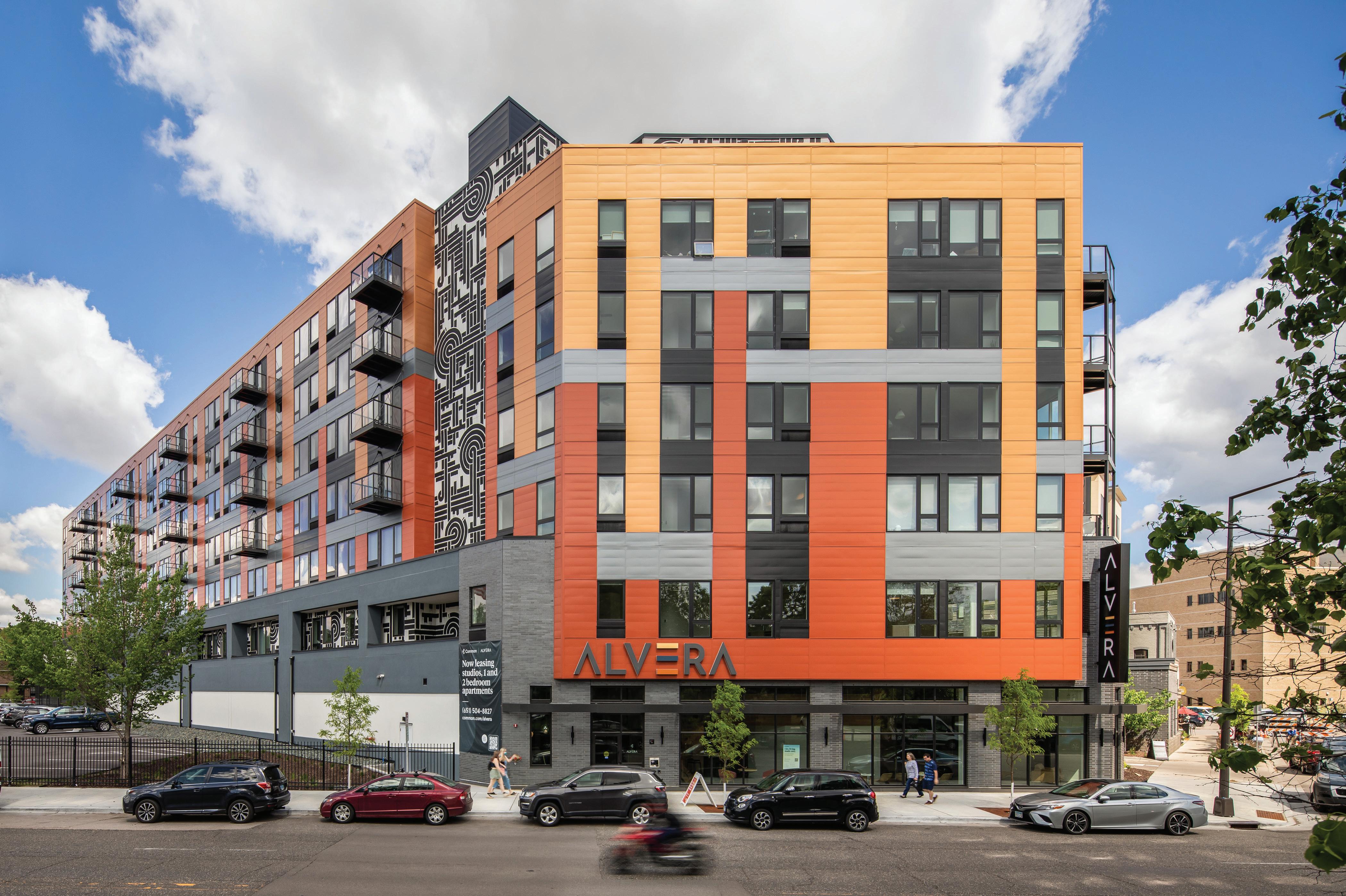
Farrell brought in fellow Madison graduate Stuart Ackerberg of the Ackerberg Group to co-develop the property. The two learned to re-envision real estate from Professor Graaskamp, for whom the University of Wisconsin-Madison’s Real Estate School is now named. The design here needed to be efficient, affordable, and have adequate parking, conceived in a way to attract the workforce from nearby Children’s, the Sci ence Museum, and staff from nearby hotels. All of which seems simple enough, but in an urban setting, projects of this nature rarely pencil-out. “We had to find a way to bring the proforma from in the red to in the black,” recalls Farrell, referring to the old ways accountants would use red ink to show losses versus profits. The turning point came from embracing bold new construction techniques in two ways: (1) implement ing an automated, stacked parking structure and (2) by using volumetric modular construction for Floors 3 through 7. Neither had been attempted at this scale in the Upper Midwest. The team would need the glue only Alvera Franceschi and her memory could provide.


The Leap of Faith

Enter Dean Dovolis, chief of everything at DJR Architecture. Dean’s genius-like nature and childlike enthusiasm makes you feel like anything is possible. Dovolis cut his chops in modular construction during the Bakken oil boom from roughly 2008 to 2014. “In the Bakken, we had to find a way to house thousands of people quickly and efficiently and modular construction was a natural fit,” according to Dovolis. But what worked for the Bakken “Man-Camps” wasn’t the kind of construction that would be needed to create multi-story buildings like what you now see on West 7th. Luckily for this team, another soon-to-be major player was hard at work build a manufacturing plant in Owatonna Minnesota that would evolve modular construction into the future.
Enter Rise Modular, LLC, a full-volumetric commercial manufacturing company founded by Christian Lawrence, CEO. Lawrence recognized the opportunity of mod ular early on. “I wanted to be a developer and incorporate modular construction in multi-story developments, which are prevalent on the East and West coasts. How ever, full-volumetric commercial modular production didn’t exist in the Midwest, so I decided to pivot and become a modular manufacturer instead. In 2019, I launched Rise and built its manufacturing facility in Owatonna, Minnesota. The company has since grown to nearly 200 employees.” As a graduate of Yale University with private equity experience, Lawrence certainly has the drive and vision to figure it out.


14 DEVELOPMENT SHOWCASE
Environmental Investigation & Remediation Industrial Hygiene Building and Structural Sciences Geotechnical Engineering & Testing www.braunintertec.com Proud to be your trusted consulting partner on multifamily projects for:
“Christian did it right,” according to Dovolis. “He scoured the nation for the best talent in modular construction and convinced them to come to Minnesota and join Rise. In a state-of-the-art manufacturing facility, designed and engineered by industry experts, the company has established a best-in-class manufacturing pro cess.” It takes but a single tour of the facility to appreciate that modular is the future of construction. It is a tradesman’s ideal work environment; state-of-theart machinery, no exposure to outside elements, and all ground-level work. In this
environment precision is unparalleled, quality is second to none and consistency easily maintained.

“The reduction in project duration results in real savings,” all team members con curred. “The foundation of the building starts at the same time module manufac turing began. When the foundation was complete Rise stacked the modules on-site and floors three through seven were completed in a short six weeks” adds Dovolis.

15DEVELOPMENT SHOWCASE
HARDING STEEL 800-727-5325 HARDINGSTEEL.COM CARBON 12 PORTLAND, OR
“It might be easy to imagine a garden-style apartment being modular, but people are blown away when they see a seven-story structure with this level of finishes.”
“The modular units are incredibly well built,” according to Farrell. “Think about it, Rise builds the apartment units in a factory in Owatonna, ships them on a truck to St. Paul, and crane lifts them into place seven stories in the air. To accomplish this, each unit has its own ceiling and floor, which when stacked together, provide twice the density. It is very structurally sound and solid.”
“It gives us tremendous joy when people see the Alvera in person; most cannot believe it’s a modular project,” says Lawrence. “It might be easy to imagine a gar den-style apartment being modular, but people are blown away when they see a seven-story structure with this level of finishes and no hint of its modular nature.”

The Parking Problem
The next problem was the bedrock under the site. “We weren’t going to be able to go underground for parking,” recalls Farrell, “and we were already height re stricted, constraining the number units going up.” Farrell thought back to his days in New York City seeing car elevators being used commonly to increase parking density. “We just haven’t seen any in Minnesota at this scale,” he added. The team was about to undertake another first.
Enter Opus and All City Elevator. Opus built the first two stories, which would house the parking and serve as the foundation for setting the modular apart ments. But it was All City Elevator President Matt Gamble and his team who were tasked to install the mechanical parking structure. “It’s really quite amazing,” recalls Gamble. “We were able to provide 102 parking stalls using six separate mechanical structures in very little space. You would need three levels of tra ditional parking to replace what we were able to effectively accomplish in two stories.”
The parking structure allowed the team to deliver 30 more apartments over what would have otherwise been possible, yielding a total of 193 units for the project. “And it’s secure,” adds Gamble, noting that security in urban neighborhoods like this one, especially during civil unrest, is a big concern. The other benefit is tim ing. One would think that as a tenant, waiting for a mechanical parking structure would take longer than a traditional parking structure. “This system retrieves your car in around 45 seconds,” according to Gamble. The All City team waned

16 DEVELOPMENT SHOWCASE
Congratulations to Opus on the successful completion of the Alvera Apartments Project. Midwest Specialty Maintenance appreciates being part of your team! PROVIDING EXCEPTIONAL CONTRACT CLEANING SERVICES SINCE 2005PROVIDING EXCEPTIONAL CONTRACT CLEANING SERVICES SINCE 2005 9225 East River Road Coon Rapids, MN 55433 763-493-2555 www.midwestspecialtymaintenance.com
See more. Our projects always have a view.



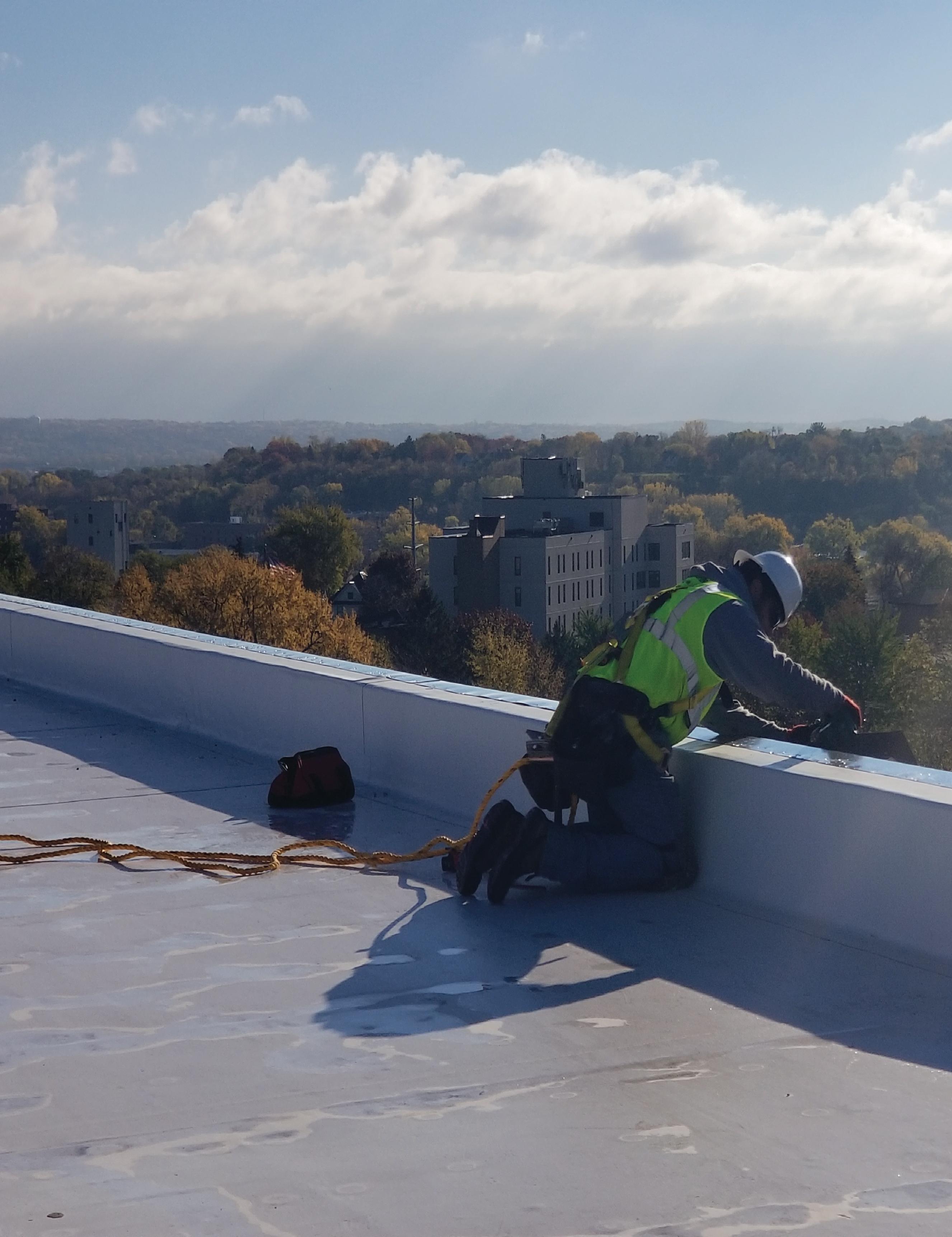
The Alvera | St. Paul, MN ROOFING CONTRACTOR: CENTRAL ROOFING COMPANY

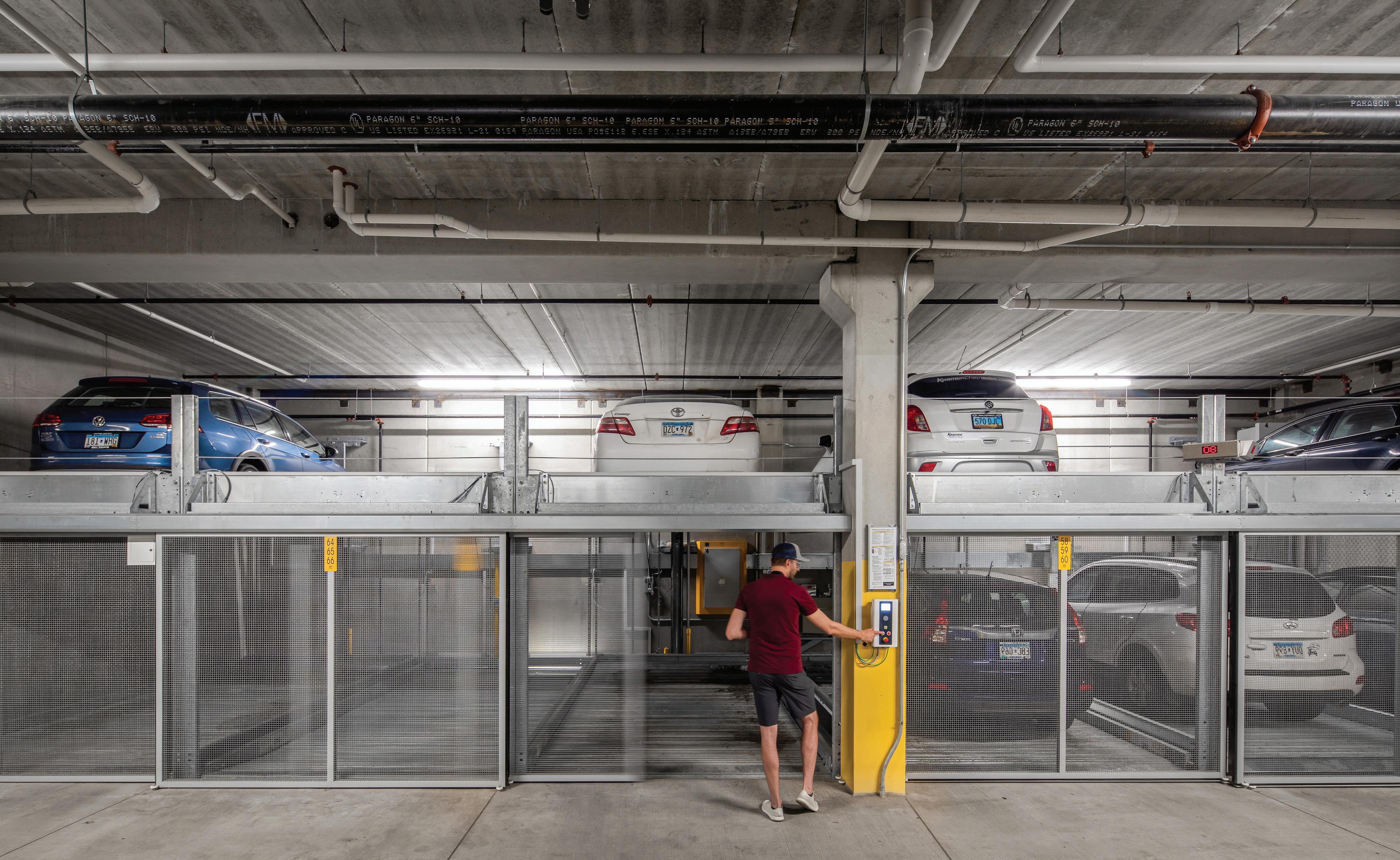
18 DEVELOPMENT SHOWCASE Enhance your community with instant-on connectivity Fast, reliable Internet from the provider of the largest Gig-speed network is just the beginning. Get your residents connected within minutes of move in — no waiting for equipment or tech appointments. Our customized solutions are tailored to your property’s needs to give you and your residents the best experience possible. All with dedicated support and 24/7 customer service. Get your property WiFi ready today xfinity.com/connectivity Restrictions apply. Not available in all areas. Actual speeds vary and not guaranteed. For factors affecting speed visit www.xfinity.com/networkmanagement. NPA231510-0006 144015_NPA231510-0006 XFCommunities WiFiReady ad 4.875x7.indd 1 9/8/22 5:13 PM World-Class Electrical and Technology LOCALLY DELIVERED SINCE 1948 • Preconstruction • Electrical Design & Construction • Service & Maintenance • Outdoor Electrical • Technology Systems Proud Provider of Electrical & Technology Services for Alvera Apartments 651.224.2833 | collinsmn.com
to compare this to a traditional parking garage, so they headed across town with a stopwatch. They found, on average, that it took 90 seconds to drive around and up and down in a traditional structure versus 45 in the automated system they installed at Alvera.
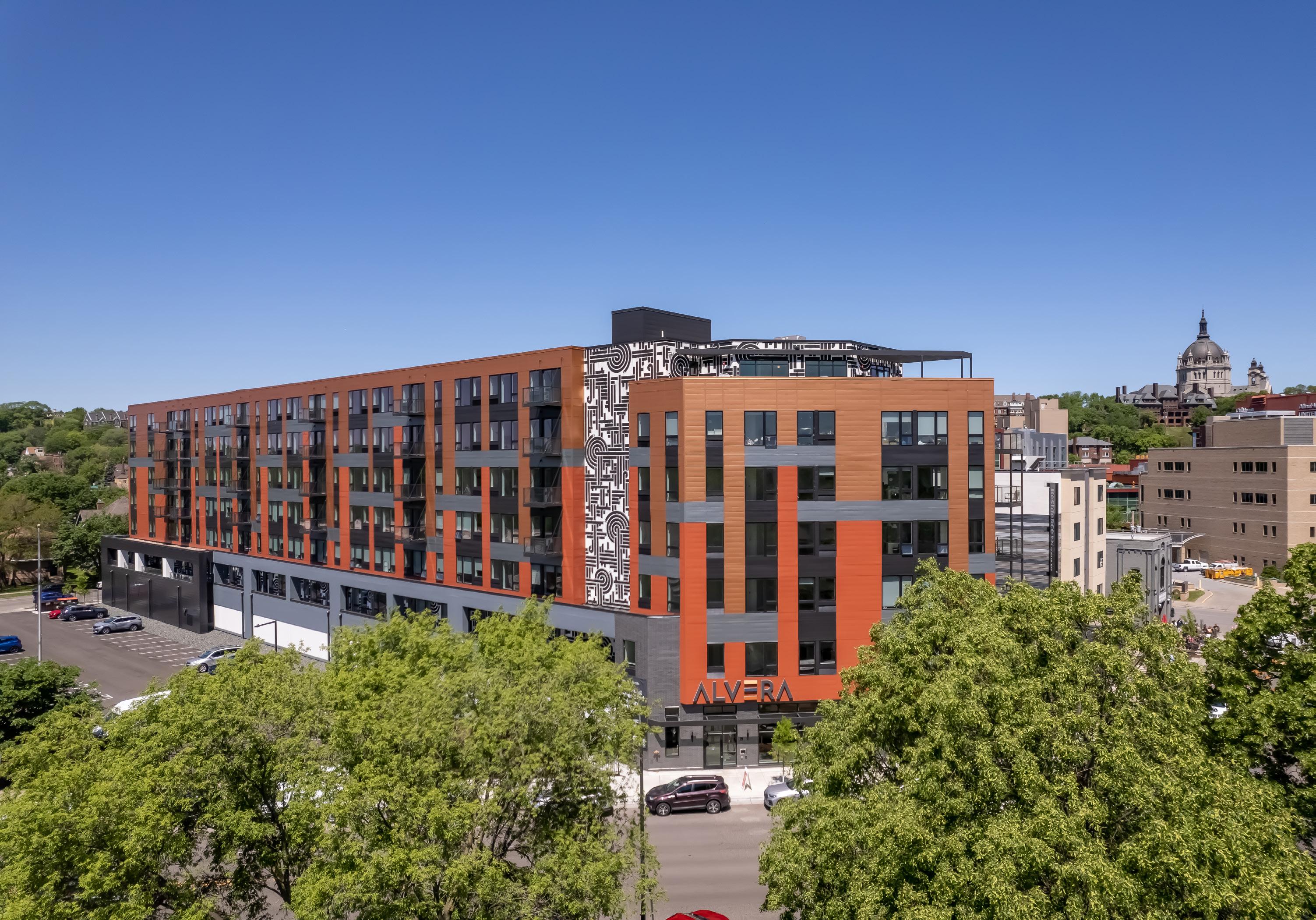
Making it Real
The final piece to the puzzle belonged to Stuart Ackerberg. “We have a respon sibility to leave this world better than we found it. We have a duty to make our buildings someplace special. And this site in particular we are working to activate the West 7th Corridor as a center for artistic expression.” It was with this mission that Ackerberg turned to Forecast Public Art in St. Paul to bring the building to life. Forecast Public Art, in turn, brought in world-renowned artist Aaron De La Cruz. De La Cruz and Ackerberg hit it off immediately. In fact, the two still talk weekly, even after the project was completed.
It was De La Cruz and Ackerberg who turned to the memory of Alvera Franceschi for inspiration. “Aaron became obsessed with the story of my mother,” recalls Ackerberg. “He wanted to know more about her, her love for art, her favorite color, and her warming personality. It set him on a mission. In fact, it set all of us on a mission. We used that energy and that purpose to shape and mold the project into what people now admire from their windows of Children’s Hospital. Even the tradespeople working day to day on the project felt inspired to leave their own chapter in the Alvera story.”
For days, De La Cruz and his team hung by a cherry-picker to paint the exterior of the building by hand. Not just a simple mural, but the whole building—all seven stories have painted elements. All told, 7,500 square feet is painted, all reflecting artwork inspired by the Alvera story.
De La Cruz was inspired by Alvera Franceschi as a mother and also as a lover of art. Her favorite color was orange. Looking at the exterior of the building, the
19DEVELOPMENT SHOWCASE
PROUD TO BE A PARTNER IN INNOVATION AT ALVERA
opus-group.com
“We have a responsibility to leave this world better than we found it. We have a duty to make our buildings special. And with this site in particular we are working to activate the West 7th Corridor as a center for artistic expression.”


20 DEVELOPMENT SHOWCASE
shades of orange not only make the building stand out, but the colors signify the coming and going of the day. Mixed in with that, De La Cruz used patterns to express a serape (Mexican blanket) to envelop the building as a mother would by putting her arms around its inhabitants. The tones and textures also carry into the common areas and rooftop deck.
Ackerberg didn’t stop with De La Cruz. There needed to be more artistic impact. The team created an “Artist-in-Residence” program whereby an artist will live in the building rent-free for one year. In exchange, the artist creates fresh and unique artwork for display in the building. Alvera Franceschi was an avid art collector. “Not the traditional, museum art you might think of,” clarifies Stuart. “But when she traveled, she would seek out local artists, get to know them and understand their art. Then we she brought home the pieces, they were meaningful because she knew the artist personally.” Ackerberg is honoring her memory by bringing in artists, supporting them through free rent and giving them a venue to create and explore their craft. “We have a duty to stimulate others,” added Ackerberg, “and to inspire other developers and builders to do the same.” The art gallery in the building will serve as a reminder to the development community that design doesn’t need to be the tail of the dog. “Design is the dog,” says Ackerberg.
Making it Affordable
The costs of construction today and the rents that are needed to support new construction are at odds with the community’s needs for urban workforce hous ing. Farrell and Ackerberg knew the project needed to serve the workers of the neighborhood in which it was being built. To accomplish this, the units needed to be efficient. “Alvera’s homes are typically in the range of four hundred to six hundred square feet,” according to Ackerberg. “In order to do that, we had to place an emphasis on the amenities,” adds Farrell. “During a time when workfrom-home was exploding, we needed to accommodate resident needs to get out their space to stretch their legs or take a phone call.” In addition to the typical high-tech gym and rooftop lounge, the team added phone booths and hidden
We connect the dots, and make the connections.
FDIC
21DEVELOPMENT SHOWCASE
BWBMN.COM Member
Discover Bridgewater Bank.
“We believe in being honest and confronting the difficult issues upfront, which helped with tackling this small site. Credit also goes to Opus for understanding the challenges of this project and working with everyone to deliver an amazing finished product.”
alcoves to provide those much-needed individual touch-down spaces. This is the landing pad for the young professional and support staff who call this building home. The design had to reflect that, according to Ferrell.
In the end, the project achieved the goal of accessible housing. Unit rents start at $980 according to the building’s website, and the building is wildly popular with tenants.
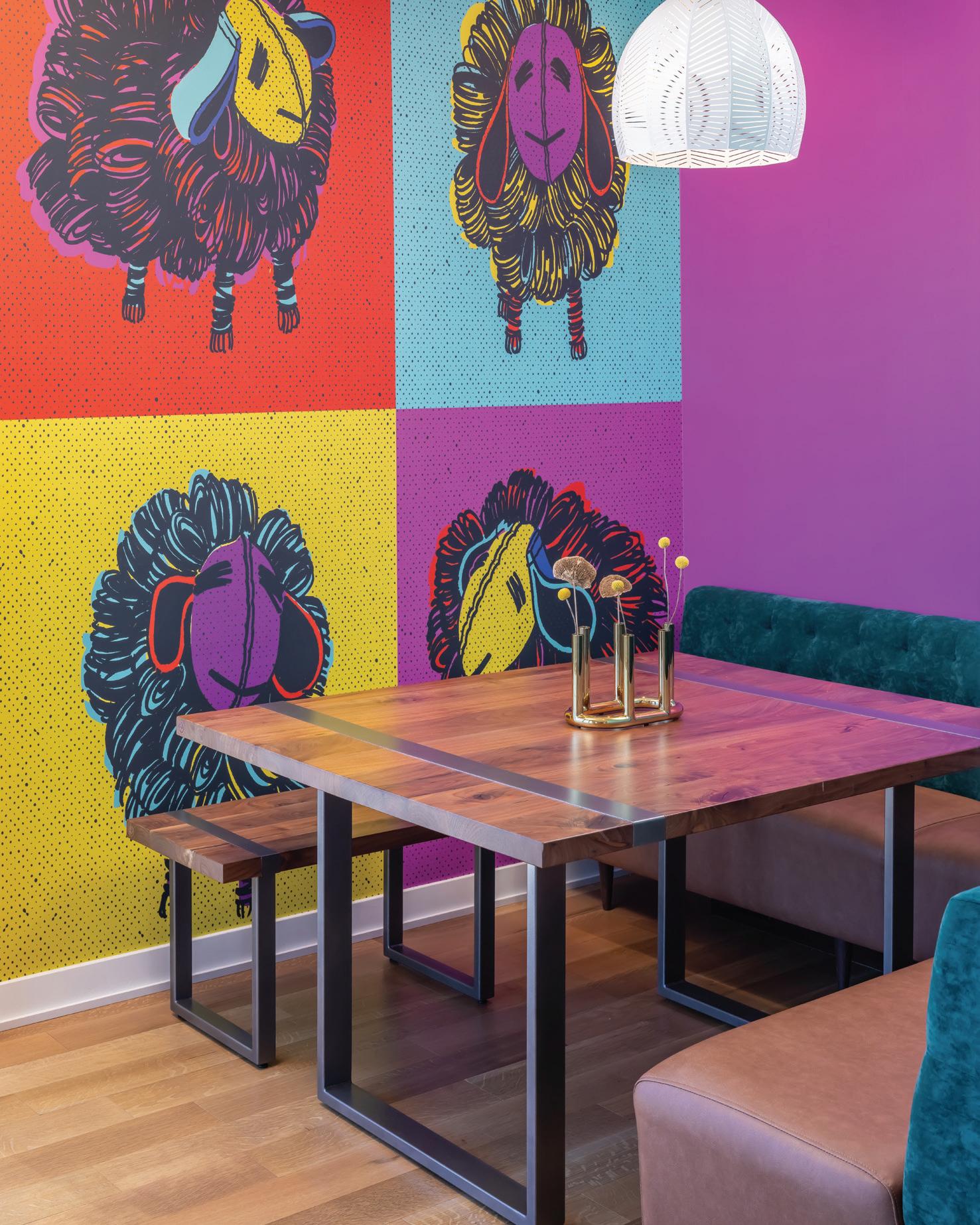
Other Modular and Construction Challenges to Overcome

Modular construction will be a big part of the industry’s future. It is promising not only for cost savings, but also speed-to-market, construction quality, and perhaps, even automation. “The biggest savings for us was timing,” according to Farrell. “We are now exploring volumetric modular for all of our projects.” The short time span from the start of construction to the first day you collect rent can generate significant savings. Not only do you save interest and other carrying costs, “your onsite management team, the trailer, the staff, and all the onsite people are dedicating less time to the project, which can result in significant sav ings,” adds Dovolis.
Dovolis’ company DJR assigned modular veteran Aaron Johnson to the job. Many credit Johnson for his impact on melding the building’s design with the intricacies of modular. When you build in a factory at the pace and timing of a modular project, one hundred percent of the design work must be done upfront. “You are making choices really early on in the process,” recalls Ackerberg. “It’s definitely an adjustment.” So much so that DJR brought in technology to help the team vir tually visualize the interior design to facilitate the unusual early timing of design.
Putting a roof on a modular building “was really just like any ither job,” accord ing to Mike Olson of Central Roofing Company. The challenge with Alvera was that the north and south sides of the building were only about six feet from the property line. “There were times when we were bringing in materials in a
Shaping the future
816.292.2000.
22 DEVELOPMENT SHOWCASE
Congratulations to The Ackerberg Group on the Alvera project. We were privileged to work with you on this building and proud to call you a client. Lathrop GPM attorneys have deep experience in all aspects of commercial real estate development, including the creative management of complex environmental situations. The firm’s robust Real Estate & Development team takes pride in partnering with our clients to achieve their development goals. Working together, we build exciting futures. Wade Anderson 612.632.3005 wade.anderson@lathropgpm.com lathropgpm.com This is an advertisement. The choice of a lawyer is an important decision and should not be made based solely upon advertisements. Neither the highest state courts nor state bar associations review, recognize, or approve certifying organizations, certifications of specialties or specialist designations in the practice of law. The certificate, award or recognition is not a requirement to practice law. Lathrop GPM LLP, 2345 Grand Blvd., Suite 2200, Kansas City, MO 64108. For more information, contact Cameron Garrison at
Lorem ipsum
wheelbarrow and hoisting some of it by hand,” recalls Olson. “We believe in being honest and confronting the difficult issues upfront, which helped with tackling this small site. Credit also goes to Opus for understanding the challenges of this project and working with everyone to deliver an amazing finished product.”
Additional unforeseen challenges, like construction lending, added to the complexities. “Modular construction might scare away many lenders at first blush,” states Ross Wiesner, Senior Vice President at Bridgewater Bank. “There are a number of issues we had to dig in and understand to develop a comfort level with this project. For ex ample, what is your security interest in an incomplete module in a factory? Who owns the modules or rather who insures the modules while they are in transit?” Wiesner concluded that Bridgewater was passionate about the West 7th Corridor, as it has an office in that neighborhood, but he and Bridgewater also believe strongly in the development team. “Ackerberg, really everyone involved, knocked this one out of the park. We believe in multifamily in the long term, and we were honored to be afforded the opportunity to be involved in such a unique project.” In the end, modular construction was just another speed bump to funding the project.
Not the Best Time to Put up A Building
The team again turned to Alvera Franceschi and relied on her strength to work through troubled times. It wasn’t the easiest time to be putting up a structure.
TOGETHER WE RISE www.risemodular.com

Ackerberg Group, Northland Real Estate Group, DJR Architecture, The Opus Group and RISE Modular came together to build the largest commercial volumetric modular project in Minnesota – the award-winning Alvera Apartments in St. Paul.


23DEVELOPMENT SHOWCASE
In the End, a Legacy
Dovolis says, “A testament to the building, and also an ongoing challenge, is the number of requests we get for tours of the building. It is really going to inspire the next generation of mul tifamily development.” Ferrell credits the creativity and leader ship by Stuart and the rest of the team at Ackerberg Group. “A project like this doesn’t happen without a progressive partner like Ackerberg.”
Alvera is truly a legacy of love and a legacy of firsts. It is the first modular project of this scale in the Upper Midwest, with the largest automated parking structure in the Midwest to date. Additionally, the inspired artwork of Aaron De La Cruz met the vision of Stuart Ackerberg and Brian Farrell to enhance West 7th in a way that no one else could at a time when it was need ed the most. Dean Dovolis will be proudly hosting tours for years to come.
During civil unrest in an adjacent community, an entire project was burned to the ground, just blocks away from the site. Add to that workplace issues related to a pandemic, and you have a recipe for a disaster. “We approached each day as an adventure,” says Ackerberg. “ It was certainly a vertical learning curve. Learning modular, dealing with site restrictions, lumber pricing, labor shortages, and dealing with pandemic-related civil unrest, we had daily hurdles to overcome. But the stronger the team, the easier it was to pivot and bounce. And our team rallied together with a positive approach to really make it hap pen.”
Project Team
Ackerberg Group
Co-Developer
Northland Real Estate Group Co-Developer RISE Modular Construction
Opus Group General Contractor
All City Elevator Parking System


Central Roofing Roofing Systems
Midwest Specialty Maintenance Construction Cleaning Service Bridgewater Bank Lender
24 DEVELOPMENT SHOWCASE
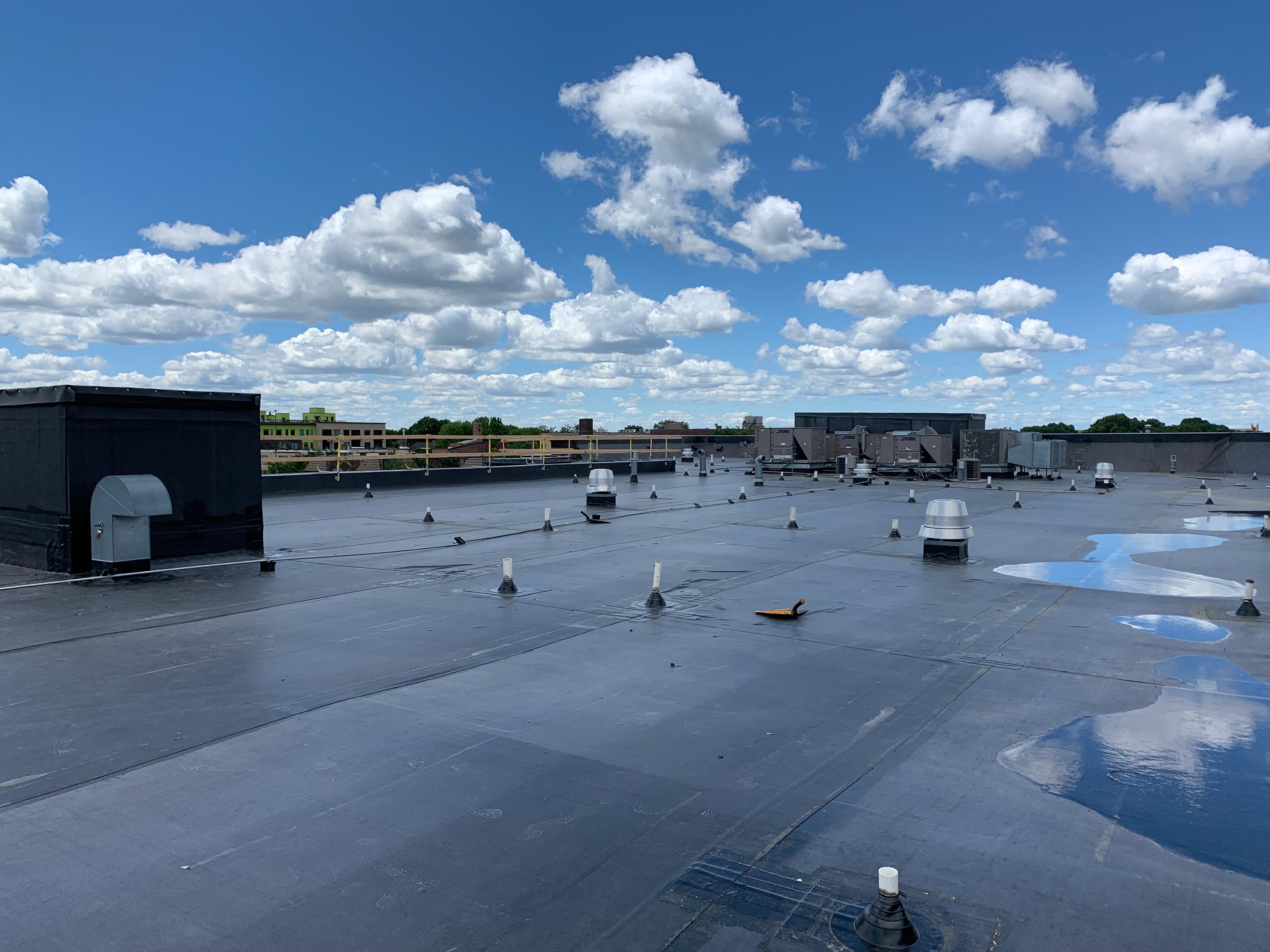
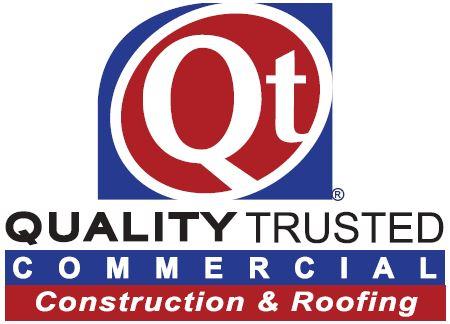
Minnesota’s #1 Roofing Installation, Repair, and Maintenance Service • • Service • • 24/7 Emergency Leak& Investigation Repair Re-Roofing and New Construction • Roofing Maintenance Plans Roofing Inspections • Storm Damage & Repairs 6909 Winnetka Ave N Brooklyn Park, MN 55428 qtcommercial.com 763-535-5831
Lagging momentum? No sign yet in the Twin Cities multifamily market
By Dan Rafter, Editor
The momentum in the Twin Cities’ multifamily market isn’t slowing, even with higher interest rates and nagging inflation. Vacancies in apartment towers in downtown and campuses in the suburbs continue to fall. Demand is still outpacing the supply of available apart ments. And investors still view apartments in the Twin City market as safe homes for their dollars.

What’s behind the enduring strength of the Minneapolis multifamily market? And can this sector’s momentum overcome the uncertainty of high interest rates and inflation?
We spoke with Ted Abramson, senior vice president for multifamily with the Minne apolis office of CBRE, to find out. Here is some of what he had to say.
It’s been a challenging two-plus years. But has the multifamily market in the Minneapolis area remained resilient despite the challenges? Is demand still high among both renters and investors for multifamily properties?
Ted Abramson: Everyone was scared back in April of 2020 about what the future might hold. But our multifamily market has remained resilient throughout the pandemic. We are seeing a significant growth in rents. We are seeing a big uptick in the demand for apartments in urban areas. Occupancy levels are much higher today. Concessions have pulled back con siderably. Our urban multifamily markets have responded quite well.
Are people returning to downtown Min neapolis? Are they looking for apart ment units in the urban neighborhoods again?
Abramson: Downtown is much busier than it was last year. We are seeing more traffic heading into the city. People want to live in the city. Opinions vary on whether we are past the worst of the pandemic. I won’t get into that. But our downtown activity looks more like it had during nor mal times. That’s a good sign.
How about in the suburbs? Are renters interested in multifamily product in the suburbs surrounding the city?
Abramson: The suburban market remains very strong. This part of the market is really leading the way on the rent growth we’ve seen. Not as many apartment units were developed in the suburbs at the be ginning of this cycle, in 2011 and 2012. So demand has remained high for units in the suburbs. When COVID started, that kickstarted the decision that many peo ple in urban areas made: They wanted to move to the suburbs. Of course, it wasn’t just COVID. People often move to the
suburbs when they start their families and they get interested in public schools. We are still seeing quite a bit of multifamily development in the suburbs to meet the demand in those markets. New deals are being done and projects being built in third-ring suburbs. And these projects tend to lease up quickly.
Build-to-rent homes – single-family homes designed to be rented out – seem to be growing in popularity across the country. Are you seeing much of a buildto-rent movement in the Minneapolis market?
Abramson: We have seen a lot of growth in the build-to-rent space. That seems to be the sexy new product, the new niche that people want. In a way, it’s like meld ing townhomes and single-family homes. The development might have a clubhouse on site that everyone can use. But the homes feel more like single-family homes, even though the people living in them are renting, not buying. We are seeing these build-to-rent developments in suburbs such as Maple Grove and Woodbury.
Why is build-to-rent becoming such an attractive option for renters and own ers?
Abramson: Part of it is that it serves such a wide demographic. It might be someone who is building a house and has two to three kids and needs somewhere to stay for six to 12 months. Or it could be a
73-year-old couple who want to spend time traveling the world but still want space for their grandchildren to come visit them. The Millennials and Gen Xers with families might want to get into a certain school district. Buying a house can be difficult today. Build-to-rent, then, isn’t just for one demographic. A wide range of people are interested in this type of housing. They can lock their door and leave, but they still have a yard. They might have access to a clubhouse with all the amenities you’d find in an apartment development. It is just a nice option for a lot of people.
It is challenging for many younger buy ers to find homes they can afford in most markets today, right? I suppose that is something that is boosting the popular ity of the build-to-rent model.
Abramson: It’s tough everywhere. Here, it’s possibly even tougher. There just aren’t enough homes available that you could consider affordable.
What about rising interest rates? Is that having an impact on the demand for multifamily housing?
Abramson: It’s not having an impact on demand from renters. They are still look ing for multifamily housing. Apartments might make even more financial sense for them as mortgage interest rates rise. In vestors are trying to understand the new paradigm of where rates are today. They
are trying to figure out how lenders, banks and life insurance companies are under writing loans today. When rates jump so much in a short time, it makes sense for investors to wait until the interest-rate environment settles down. But any pause we had in the summer was short-lived. Activity from investors in the multifamily space is definitely back today.
How is the supply of multifamily hous ing in the Twin Cities and its suburbs?
Abramson: We don’t have an oversupply. There are locations where we have seen a lot of new multifamily development. But our market has been stable overall. We are certainly not overbuilt, so demand for apartment units remains high.
Can you talk a bit about amenities? What type of amenities are renters looking for from newly built apartment developments?
Abramson: There was a race for new amenities at the beginning of this strong multifamily cycle. People were adding golf simulators, high-end pools, anything to set themselves apart. Today, developers are focusing on that work-from-home space, that collaboration space. Many renters still aren’t going into their offices, at least not on a full-time basis. So they want places from home where they can work. That might be conference rooms in a building’s common areas. If you are living in a one-bedroom or studio, do you
26 OCTOBER 2022MINNESOTA REAL ESTATE JOURNAL
The Laguna Apartments in Minneapolis’ Uptown neighborhood.
to spend all your time working from
unit? Probably not. So instead of providing that big community room, new buildings today are more often providing break-out spaces that people can use when working from home.

Speaking of working from home, are you seeing more people back to work in the CBD of Minneapolis? That would provide yet another boost to the apart ment buildings in urban areas.



Abramson: We have an intern who has been in the office every single day. It seems that many people in that younger cohort of workers want to be back in the office, at least on a part-time basis. They want to be able to meet people instead of spending all their time working from home. There is a group of people who would rather not come back to the office. But there is a group that wants the option to work from the office, too. Target recently announced that they were giving their workers at their corporate offices the choice to work from home or come into the office. As soon as they announced that, the next Monday
I noticed a big uptick in the number of people downtown. Target had empowered its employees to make that choice. That younger demo of employees wants to come back to the office. They want that sense of community.
Looking to the future, do you see de mand for multifamily housing, both from renters and investors, continuing to rise?

Abramson: We will continue to have demand from investors for Twin City multifamily housing. Renters, too, will
continue to seek out apartment living. If it gets more expensive to buy a house, if mortgage interest rates continue to rise, more people will stay put in their current single-family homes for a longer time. That makes the barrier for entry for firsttime homebuyers even more challenging. Combine that with the silver tsunami of former homeowners who want to move out of their single-family homes and move downtown, and there are some strong fac tors fueling the multifamily market.
27OCTOBER 2022 MINNESOTA REAL ESTATE JOURNAL Available 9600 Sq. Ft. Eastgate Business Center 2nd Floor - Elevator Close to Downtown – University St. Cloud, Minnesota Hwy 10 & 23 Intersection High Quality Finishes Top Tier Connectivity w/ Fiber Furnished Space Competitive Lease Rate Quality Tenant Mix Free Parking Ask About Broker Incentive RCA Real Estate Bob Abel (320) - 267 - 6003 Chris Abel (320) - 980 - 0788 assistant@rca-re.net www.rca-re.net See Our Website For Video want
your
The Minneapolis Grand Apartments in downtown Minneapolis.
The 410 Apartments in Minneapolis.
vancement that will continue to enhance the individual experience we offer.




Everything is going online. The pandemic really pushed this trend. People are more comfortable with that online engage ment today. Whether it’s yoga classes or mixology classes, we do so many things online today. Prior to the pandemic, JLL introduced an entire business platform, called XM or Experience Management. It’s a concierge service that we can provide remotely. That used to be something prop erty management personnel did from their desks. Building owners, though, recognize that if a concierge service is something that helps brings employees back to the build ing, they need to offer a concierge service on steroids. You need to offer these options to building tenants. It’s a ‘check-the-box’ item. That experience needs to be available to them. It’s no different than fitness cen ters were five years ago.
Wright: The Class-A spaces have the ame nities that tenants are looking for. They have the amenity centers and the confer ence centers, the ability to plug in higher levels of technology. The buildings are run with smart systems. The mechanical systems are precise and they are reliable. The older buildings in Minneapolis, the Class-B and Class-C properties, are falling
a little bit behind. They just don’t offer as many amenities as the Class-A buildings do.
The other thing that Class-A properties spend money on is security, the whole es sence of keeping a building safe and secure for tenants and their employees. That is a very big issue. In Minneapolis, we were the start, the epicenter of the social unrest a couple of years ago. There is an onus now on building owners and managers to make sure buildings are safe and secure.
Another big thing in Minnesota is outdoor space. Do you have outdoor space that tenants can migrate to during the course of the day? Part of the conversation between property managers and owners is figuring out how to create good use of the outdoor space available in buildings.
What else has to happen to get more peo ple back into the office?
Balsiger: It’s not just what the building is doing. It’s what the businesses are doing. Whether they are buying their employees lunch one day a week or offering a social event once a month. Maybe it’s flex sched uling. The businesses themselves must establish a new culture to not only recruit people but retain those people and bring them back into the office. In every business there are always going to be roles in which the individual can be effective working from home. But there are also a lot of roles
where people need to be in the office and collaborating, whether you need to work together on a pitch or you are working on underwriting for a larger-scale construc tion project. Whatever your business is, there are certain functions where people can be effective from home and others where they need to be in the office.
What should business owners ask when looking for the right property manage ment firm to partner with?
Wright: We get asked a lot of questions when talking to building owners. Some of the questions that are being asked today are not the ones that would have been asked 10 years ago. Owners today, for instance, should be asking about environmental and sustainability changes they can make. Those are highly important issues for many employees and tenants today. What can a property management firm do to help building owners improve the efficiency and environment of their buildings?
Owners should also ask property manage ment companies about how much commu nication they will have with their building’s tenants. How much will the property managers interface with tenants on a daily, weekly or monthly basis? They should also ask property managers what they can do to be part of the solution for their tenants as they attempt to bring employees back to the office.
In every interview we have with building owners today, the environmental, sustain able and social governance questions and the questions about tenant engagement and retention are a focus.
Balsiger: It comes down to the culture of the property management organization they are looking to partner with. Do you want a partner or just a service provider? The more information a client shares with us about their goals for the asset, the more effectively we can act as a partner and not just a service provider. If clients are really open with us, we can do a better job of managing that asset for them.
For instance, if we know the client is going to be a short-term holder of a property, we might not dig into the back-end operations of the building so much. We won’t focus on those bigger details of running a building more efficiently. But other clients who say they want to hold onto a property for 10 to 15 years, we will focus on what we need to do to make it more efficient.
When I am pitching a client, I also com mit to them. I tell them that if we assign a general manager to their building, that general manager will be with them for two to three years. If the client is a long-term holder, that general manager will be with them even longer. Having continuity in your management team is critical to being a cohesive rapport. And that is critical to a property’s success.
Thank
28 OCTOBER 2022MINNESOTA REAL ESTATE JOURNAL
MANAGERS (continued from page 6)
You to Our Sponsors!
Long-Awaited Project Schafer Richardson delivers Rya at RF64 in Richfield
The Richfield housing market is one of the hottest in the Twin Cities, and the new, contemporary apartments offer unique options for residents who want to call the popular, first-ring suburb home.
 By Liz Wolf
By Liz Wolf
FFollowing years of diligent work by the city of Richfield and the Schafer Richardson development team taking the reins, the long-anticipated, Class A, Rya at RF64 opened this summer. The two-building, four story mul tifamily development brings new housing opportunities to the community and continues to transform the Cedar Point area on Richfield’s east side.
Demand has exceeded expectations. To date, the multimillion-dollar, 237-unit development, which opened in two phases – on June 1 and July 1 – is 51 percent occupied and 65 percent leased.

“Leasing has been phenomenal,” says Brenda Hvambsal, vice president of mar keting at St. Louis Park-based-based Steven Scott Management, which is handling the leasing and property management. “It has been very well-received by the market.”
The project is part of a larger redevelopment area that includes 72 for-sale town homes, developed by NHH Properties and Boisclair Corp., which are selling as quickly as they’re delivered.
The two-block redevelopment site is across Richfield Parkway from the Target and Home Depot stores at Cedar Point Commons, near Highway 77 and 66th Street. The city created a tax increment financing district that incorporated both projects. TIF for the apartments totaled $4.8 million.
City aims to increase housing, density
“Richfield can only redevelop, so to maintain and increase population to support our community and schools, we can only densify,” explains Julie Urban, Richfield’s assistant community development director. “And so much of our apartment stock was built in the 1960s. We have very few apartment buildings that have elevators or modern amenities. We’re lacking even simple things like community rooms. Rya at RF64 provides a diversity of housing stock as do the new townhomes.”
Richfield designated this area for redevelopment in 2004, later guiding it for high-density housing to provide a transition between the retail development and airport to the east and the neighborhood to the west. In 2014, to jumpstart redevelopment, the city acquired 14 single-family houses along 17th Avenue for the construction of Richfield Parkway.
The city has wanted to redevelop this site since before the 2008 recession when Ryan Cos. US Inc. developed Cedar Point Commons. However, when the housing market crashed, plans stalled. In 2015, the city selected master developer NHH Properties, which partnered with Boisclair Corp. on the townhomes. The master plan also called for two multifamily buildings, however, traction lagged to get those off the ground.
Schafer Richardson gets the ball rolling “NHH and Boisclair master planned the site and saw great success with the initial phases of the townhome development, but the multifamily piece had different challenges in getting off the ground,” explains Katie Anthony, vice president of development for Minneapolis-based Schafer Richardson. “A broker connected them with us, and we said, ‘Yes. We’re interested in this site, and we can take the ball and move it forward from here.’”
Schafer Richardson acquired the 3.5-acre site for $4.65 million. The company’s expertise includes 27 years of developing exceptional commercial, residential, and mixed-use projects throughout the upper Midwest. The company boasts more than 3,000 multifamily units and has invested more than $750 million in the Twin Cities market. Additionally, it has more than 500 residential units currently under development. Schafer Richardson was named the MN Real Estate Journal 2021 Developer of the Year.
Location, location, location
Schafer Richardson was attracted to the site due to its proximity to the Minne apolis, St. Paul, and Bloomington job centers including the Minneapolis-St. Paul International Airport and Mall of America. Located across the street from Cedar Point Commons, the site offers many dining and shopping options. Numerous parks, bike paths, and community amenities are also within walking distance.
30 DEVELOPMENT SHOWCASE

“Richfield is a hot market,” notes Anthony. “I think it’s been overlooked for the past several decades, but there are many great things about Richfield, and people are recognizing that.”
She says there’s strong demand to live close to the urban core, but not nec essarily a need to be right in the urban core, which is one of the attractive aspects of the site.
“Rya at RF64 is at the crossroads of a lot of different infrastructure and com munity amenities,” Anthony adds.
New financing partners
Funding sources for Rya at RF64 include the city of Richfield; Old National Bank, which provided the construction loan; and Bridgewater Bank, which provided the TIF note. The project also includes developer equity and Schnei der Downs as an institutional equity partner.
“Old National Bank was excited to provide a construction loan for this project, because of our relationship with Schafer Richardson and because we knew the project would be successful,” says Kevan Hanson, senior vice president, commercial real estate relationship manager at Old National Bank. “We felt the project quality/design and price point were a great value proposition and believed in Schafer Richardson’s ability to perform.”
Old National Bank likes that Richfield is a mature, fully developed submarket with high barriers to entry.
“Much of the local housing inventory in the area is older product, and we could see how well other new projects had been received,” Hanson contin ues. “This site was especially attractive due to its blend of a residential/neigh

borhood feel, access to transportation, and nearby green space such as Taft Park, Lake Nokomis, and the Minneapolis trail system. Now that construction is complete, we’re thrilled to see market demand exceed our expectations.”
Continuing assembling the ‘A team’
Bloomington-based Kaas Wilson Architects is the project’s architect and in terior designer. The firm was the architect on the townhomes and did the original site planning/design for the multifamily buildings.
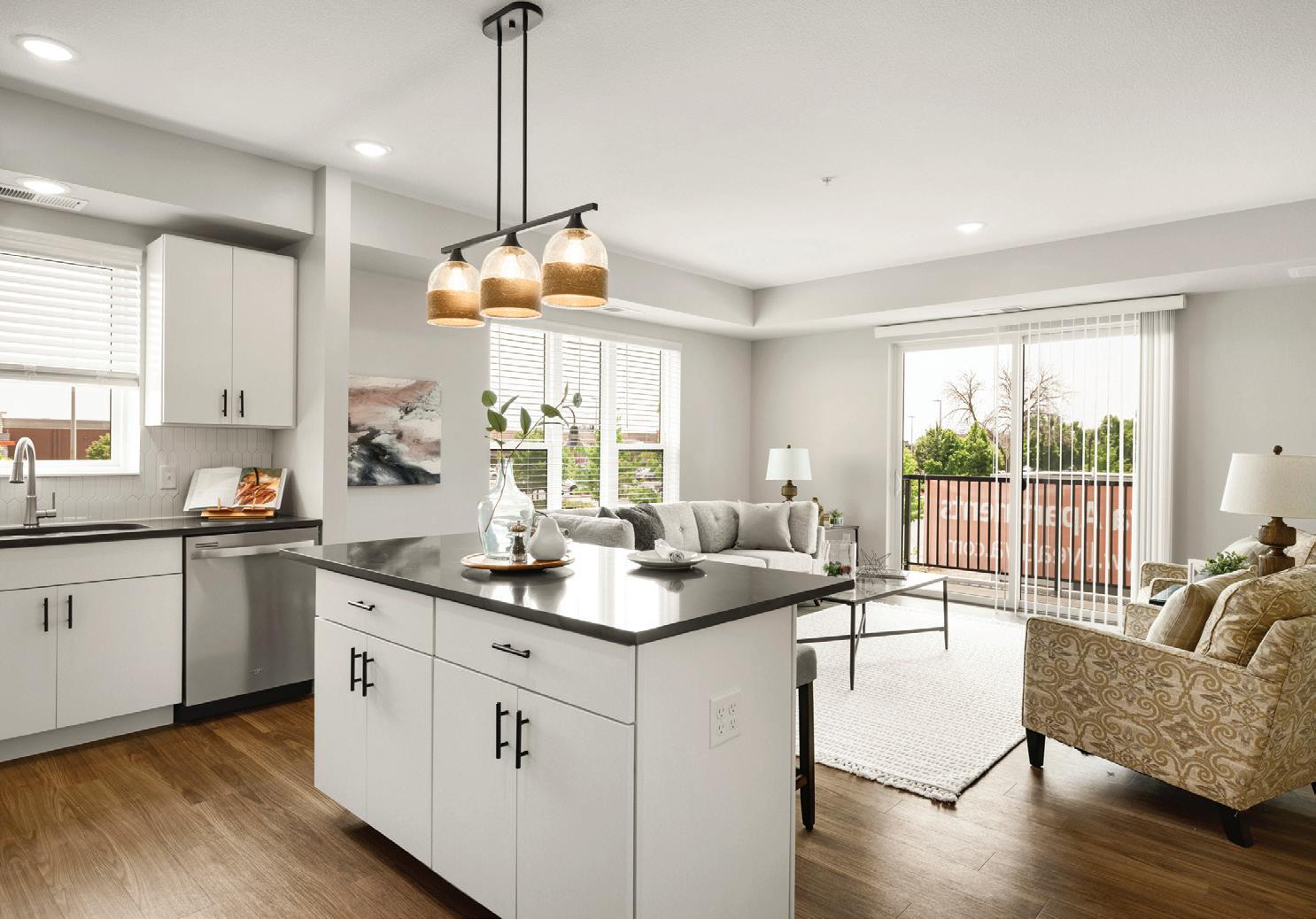


“They’re well-known in the area, and it made sense to continue utilizing them because they had all the knowledge of the site,” says Anthony. “It has been a great relationship.”
Kaas Wilson was excited the project ramped up again.
“Once we were engaged with Schafer Richardson, and they had new financing backing the project, we started communicating with city staff and our internal design team,” explains Petro Megits, associate partner, director of business development at Kaas Wilson.
He says the city wanted a horizontal, mixed-use project, using various den sities of housing as a buffer zone to the single-family homes directly west of the site.
“It has worked out really well and is successful,” Megits says. He praises the city’s efforts. “They have a progressive approach,” says Megits. “They’re figuring out ways to densify the city because they’re fully aware that Richfield is a desirable city. People want to live there.”
32 DEVELOPMENT SHOWCASE
Pandemic, supply constraints, material costs
Schafer Richardson closed on the financing and acquisition of the site and broke ground in March 2021, and Anthony says they were aware of the challenges around COVID.

“But one of the largest issues was lumber costs and other material costs that came out of the blue,” she explains. “You close one day and then two days later get the news that lumber costs have spiked. The supply chain and some of the pricing volatility across the supply chain, particularly early on in the project, were challenging, and it required us to be diligent and creative. That included the whole team -- the architect, contractor, and developer.”
Anthony says they were tasked with finding ways to save money by respecifying materials or doing something more efficiently to keep the project on budget. “We were fighting against the headwinds of inflation,” Anthony adds.
Timely delivery
“The Schafer Richardson, Kaas Wilson Architects, and Eagle Building Co. team worked hard to deliver the Rya at RF64 development ahead of schedule, con sidering the challenges that exist in today’s market,” says Mark Tangen, project executive at Richfield-based Eagle Building Co., the project’s general contractor.
“Supply constraints posed challenges throughout the duration of the project, but as a team we were able to overcome these challenges and still deliver the project ahead of schedule,” he continues.
The first building was turned over in a little less than 14 months, and the second building a month later. Both buildings were delivered more than six weeks ahead of schedule.
“Rya is a great addition to the city of Richfield, and Eagle Building Co. is happy to be a part of this successful project,” Tangen adds.

blend of




neighborhood
to
exceed
nearby
the team
a successful
At J-Berd we deliver unparalleled creative and affordable solutions. We provide expertise in plumbing, heating, and cooling systems as well as electrical and fire protection systems. Wherever we work our clients benefit from a streamlined, safe and simplified process led by well-informed professionals. Set your project up for success with J-Berd Companies.
33DEVELOPMENT SHOWCASE
OUR TEAM. YOUR SUCCESS.
sfsprinkler.com j-berd.com berdelectric.com (320) 656-0847 Congratulations to
that put together
project at the RYA at RF64! “This site was especially attractive due to its
a residential/
feel, access
transportation, and
green space such as Taft Park, Lake Nokomis, and the Minneapolis trail system. Now that construction is complete, we’re thrilled to see market demand
our expectations.”
More challenges
Another challenge was developing two projects -- the town homes and multifamily – simultaneously by two different owners.
“The new infrastructure and on-site amenities required coordination between the two developers/general contrac tors,” Anthony explains. “Because they’re separate owners, we had to make sure that we’re providing the infrastructure that everybody needs and not duplicating it, but also making sure that there’s clarity around where those are divided and located.”
Megits notes it was a restricted construction site.
“Everybody worked well in the ‘sandbox,’” he says. “Every body understood the challenges, even to the point where we had to do some on-the-fly modifications because of the tight site. I cannot commend the team more for understanding the complexity of this project and moving it forward.”
Tweaked unit mix
Rya at RF64 consists of apartments ranging in size from studios to three-bedroom units. Schafer Richardson exercised due diligence regarding unit sizes and absorption and tweaked the unit mix by adding more smaller units and expanding the overall number of units.

Roughly 30 percent are studios/alcoves, 37 percent are one bedrooms, 30 percent are two bedrooms, and eight units are three bedrooms. It has proven a successful unit mix.


“We’ve seen strong absorption across unit types,” Anthony points out. “The leasing team’s conversion rate week over week has been strong. It’s over 30 percent, and at times close to 50 percent. People are seeing the property and signing leases in short order.”
Who’s it targeting?
The first question Kaas Wilson asked was who is Rya at RF64 designed for?
“The answer was everybody,” Megits says. It’s in an interest ing, strategic position where it can accommodate downsizing baby boomers or a flight attendant or pilot who need space to touch down after a 24-hour shift, he explains.
“There’s quick access to downtown and employment sec tors,” Megits continues. “That’s why in my opinion it’s doing so well. Kudos to the city staff and their urban planners for finding an optimum location to accommodate the project, and kudos to the development team for having the vision to move forward.”
A diverse group of residents are signing leases across differ ent demographics, including families, young professionals, empty nesters, roommate situations, and people new to the Twin Cities, says Hvambsal.
In a submarket like Richfield, she says many longtime home owners want to stay in the area but need different housing options. Empty nesters may want to sell their home and rent but need elevators and amenities, and much of the rental product in Richfield is older. Rya at RF64 offers residents the
34 DEVELOPMENT SHOWCASE
option to stay in Richfield. Also, residents moving out of single-family homes opens availability for others to move into the community.

Exterior design
The buildings utilize a variety of siding materials including brick, metal panel, and cement fiberboard, which are durable and low maintenance, explains Christian Borgan, Kaas Wilson architectural project manager.

“The materials complement the townhomes that were already under construc tion,” Borgan says.

In fact, all the buildings in the Cedar Point area complement one another includ ing the commercial.
“We have a different color palette than the commercial but similar characters and masonry,” Borgan notes. “That was one of the main elements we wanted to pull into the apartment buildings specifically was to create a similar language but not identical by any means.”
Borgan adds it’s rewarding to design buildings that fit so well with the fabric of the area and echo the design of the townhomes.


Interior theme
“Rya is actually a type of knot that’s used in weaving,” explains Caitlin Carter, interior designer at Kaas Wilson. “We were able to take that idea of the rya knot and incorporate it throughout the buildings.”
Kaas Wilson integrated the theme in various ways including the built-in elements like the trim on the walls in the lobby and community room, the lighting ele ments, and wall covering designs, even down to the artwork and fabric on the furniture. (The interior incorporates work from local artists; Nolo Art Consulting was the consultant).
35DEVELOPMENT SHOWCASE
Congratulations
on the completion and success of Rya at rf64 apartments!
www.liveatrya.com
Steven Scott Management www.steven-scott.com
The rya knot theme also extends through the corridors with the same accents, shapes, and colors. Kaas Wilson brought in oranges, greens, and yellows and “wanted a color palette that you can mold and change and make as timeless as possible,” Carter notes.
The soaring lumber prices posed some challenges for the interior design, but Carter says they fought to keep major elements.
“Probably the biggest was the vapor fireplace,” she says. “It’s a cool element and a new product. At the time, there was only one other apartment project in the Twin Cities that utilized a vapor fireplace.”
A water vapor fireplace is a ventless fireplace with three-dimensional, realistic flames. The flame illusion is created with the help of fine water mist and LED lights that reflect off of it.
Carter says it was also important to retain accents like the fine trim on the walls. “These types of lower-cost features make a big impact and were really the driving force of the project,” she says.
High-end features
Unit features include stainless-steel appliances, quartz countertops, backsplash, and in-unit washer/dryers. Two variations in cabinet and counter finishes provide tenants with options for their living experience. The design also incorporates energy-efficient and sustainable choices for the eco-conscious resident. Schafer Richardson participates in the Energy Design Assistance program through Xcel Energy and CenterPoint Energy.
Additionally, many units have spacious balconies, many offering views of Taft Park and green space.
Abundance of amenities
“When we develop a market-rate project, there are amenities that prospective residents expect to see including a 24/7 fitness area, a community room that residents can check out for bigger parties, and co-working space,” notes Anthony.
Rya at RF64 is chock full of amenities, boasting two outdoor amenity decks with a swimming pool, a bocce ball court, grilling stations, and firepits. Indoor amenities include two fitness centers with on-demand fitness options, a clubroom with kitchen, conference room, library, bike storage, and multi-functional co-working/ breakout spaces.
The community provides state-of-the-art Luxer package systems. Both buildings provide one level of underground, secure parking and surface parking stalls.
Additionally, St. Louis Park-based Lelch Audio Video, one of the fastest-growing technology integration companies in the Twin Cities, provided the audio/visual technology throughout Rya at RF64.
“We used Crestron as the primary user interface (for the main brain and touch screens) with Crestron speakers, a Seura outdoor TV, Samsung frame TVs, and Sony displays,” says Alex Lelchuk, founder/president of Lelch Audio Video.
“All of the electronics are managed so remote system maintenance is a breeze,” he explains. “Having a system that’s easy to use and reliable is critical for building success.”
The key factors used to accomplish that goal are having a user interface and workflow that are consistent throughout the buildings.
“So, a resident using the community room operates that space the same way they operate the outdoor TV,” Lelchuk explains. “When you walk up to an inter face, it needs to be logical, informative, intuitive, and most importantly, similar to the other ones on the property.”
Lelchuk also says proper speaker design and layout can be the difference between the space sounding just right and balanced or being too quiet and not giving the space the ambiance, or the audio is too loud and uncomfortable.
Soaking in nature
The Rya at RF64 included improvements to the Lake Nokomis-Minnesota River Regional Trail along Richfield Parkway and a dedicated “pocket park” adjacent to the building with communal seating and a bike fix-it station available to the public.
Located across the street from Taft Park and Taft Lake, and less than a half mile from Veterans Park, residents can enjoy connecting bike paths, walking trails, athletic fields, and a playground just steps from their home.
Three locally commissioned art sculptures are prominently featured on the site, offering unique designs representative of Richfield and Rya at RF64. Two sculptures entitled “Urban Cattails” reference the prairie and marshland that existed before Richfield was developed into a city. They were designed by Remo Campopiano and Hossle Woodworks. The third sculpture is entitled “Breeze” and was designed by Foster Willey. All three pieces were commissioned by Northeast Sculpture Co.
Each element throughout Rya at RF64 was carefully appointed. The attention to detail is one reason it’s outperforming leasing expectations. The project also provides the city with much-needed, new housing opportunities.

“We’ve been through a pandemic, supply chain issues and challenges, and all sorts of things, and we’re finally here and celebrated the opening,” says Urban.
“It was an amazing team effort,” adds Anthony. “We are truly grateful to all of the partners who contributed to this project.”
Congratulations to all involved in the Rya at RF64 project!
Old National Bank and our team in Minnesota are proud to have been a part of this project.
Hanson, SVP, Commercial Real Estate
kevan.hanson@oldnational.com
36 DEVELOPMENT SHOWCASE
Kevan
763-656-1696 |
oldnational.com
We love our stuff: Investor interest in self-storage space still on the rise
How much extra stuff do Americans bring into their homes each year?
StorageCafe says that one in three Americans have so much that they need to rent self-storage units to hold it.
This isn’t a new trend, either. StorageCafe also reports that as of 2022 the amount of self-storage space in the United States had risen to more than 1.6 billion square feet.
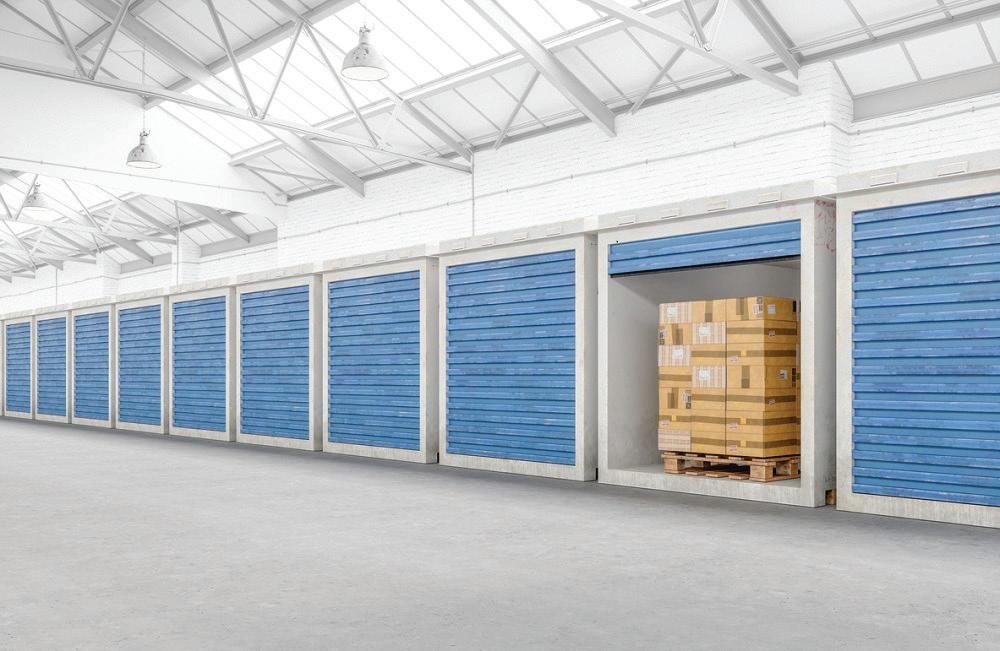
Developers aren’t shy about adding new space to the market, either. During the last five years, they’ve built 258.9 million square feet of storage space, equal to 16.1% of the country’s total inventory, according to StorageCafe.
Last year, nearly 45.2 million rentable square feet of self-storage space was brought to the market in the United States. As StorageCafe says, this amount of space could cover all of New York City’s Central Park.
And this demand is showing no signs of lessening, despite rising interest rates and high inflation, said Frank Forcier, director of business development at Store Space, a self-storage owner with Midwest locations in Michigan, Illinois, Indiana, Missouri, Ohio and Wisconsin.
“We’ve had a very good case study with COVID the past few years,” Forcier said. “And it’s proven what we’ve long said: Self-storage is a good investment in good times and self-storage is a good investment in bad times.”
What’s interesting about this is that self-storage is not a need for people. If they are struggling with bills, they’ll pay their monthly apartment rent and not their monthly self-storage fee. Paying for a stor age unit is more of a want than a need.
So why, then, is the demand that U.S. consumers have for self-storage space seemingly on a never-ending rise? Why isn’t demand for storage space falling as inflation makes groceries, gas, housing and furniture more expensive?
Forcier says that the reason is simple.
“Americans continue to love to acquire stuff,” he said. “Sometimes people look at the four Ds to explain self-storage: death, divorce, dislocation and downsizing. But there is so much more in people’s lives that spurs the need for self-storage. Those events continue to happen in good times and bad.”
For instance, homeowners might move to a smaller house. Instead of donating or throwing away their extra stuff, they might choose to store some of their items in a self-storage unit. Others might be moving to a larger space as their families grow. As
they are trying to sell their home, they’ll turn to self-storage to store much of their personal belongings to remove the clutter from their current residence while it’s on the market.
Businesses, too, often turn to self-storage. Many businesses have downsized to small er office space during the COVID-19 pan demic. They, too, might rent a self-storage space until they determine what to do with their extra furniture and equipment.
During the pandemic, many homeown ers turned extra space into home offices, classrooms and workout facilities. To make room for these new uses, they placed plen ty of furniture in self-storage facilities.
Even sports leagues turn to self-storage as a place to store their nets, balls, cones and other equipment, Forcier said.
“We rent self-storage space on a monthly basis,” Forcier said. “We are easy to get into and out of, unlike a lot of facilities where you are forced to take out longer leases. We laugh at all the stuff Americans have. But people are acquiring more and more stuff. We love our stuff. I don’t see that changing in the future.”
That doesn’t mean that professionals work ing in the self-storage space don’t have concerns. Forcier said that one of the hot topics in the self-storage industry today is whether certain markets are overbuilt when it comes to storage units.
The self-storage space, though, operates a bit differently than do other commer cial sectors. As Forcier says, self-storage operates on a hyper-local basis. Most self-storage facilities only draw customers from within five miles of their locations. This means that it doesn’t matter if a rival self-storage facility sits 20 miles away. That facility is not considered a direct compet itor.
Rising construction and operating costs –thanks largely to rising material and labor costs – are a concern for self-storage own ers and investors, too, Forcier said.
It’s true that it costs less to build a self-stor age facility than it does to build a hotel or apartment building. That doesn’t mean, though, that rising costs don’t still impact self-storage owners.
“Rising prices come into play regardless of whether we are less expensive than a
By Dan Rafter, Editor
hotel,” Forcier said. “Land prices are rising. All the soft costs regarding permitting and regulation are rising, too. Labor and materials cost more today. This is creating headwinds for all of us.”
But still, the owners of self-storage spaces are still realizing good returns on their investments, Forcier said.
“We are figuring out a way to work around the higher costs, just like anyone would,” Forcier said. “The pipeline of new self-stor age facilities continues to get bigger and bigger. There is so much interest from developers and from new investors in this segment. With all the new players, it will be interesting to see how competitive this industry gets. A lot of people are entering this sector because the word has gotten out that this is a great asset to be in.”
One important benefit to owners is that self-storage facilities require little staffing. They also last for a long time, with Forci er saying that it’s not unusual to have a 1980s-built facility that is still relevant to today’s customers.
This sets self-storage facilities apart from other asset classes such as hotels, apart ments and offices, where owners have to frequently replace carpets or furniture or make other updates on a more frequent basis.
At the same time, self-storage facilities cost little to operate while generating high returns.
Forcier said that there is about 50,000 self-storage facilities in the United States. Only about 30% are owned by REITs and large groups, he said. The rest are owned by independents. That 30% figure, though, is growing larger, Forcier said.
“There is a growing interest from larger investors who want to get into this sector,” Forcier said. “They are buying up the inde pendent facilities.”
As with all CRE sectors, higher interest rates have had an impact on investor de mand. Forcier said that these higher rates will slow the pace of self-storage acquisi tions, but not by a lot. He said he has seen self-storage deals that have been put on pause, and others that have fallen apart.
But for the most part, investors will contin ue to seek self-storage assets because their benefits outweigh the higher costs brought on by rising rates, Forcier said.
“A lot of these large investor groups have big buckets of money that they need to spend,” Forcier said. “They will continue to spend.”
37OCTOBER 2022 MINNESOTA REAL ESTATE JOURNAL
“There is a growing interest from larger investors who want to get into this sector. They are buying up the independent facilities.”
Most new units since 1972: Developers building apartment units at a record-setting pace
By Dan Rafter, Editor
Abuilding boom. That’s what the U.S. apartment market is seeing this year, according to the latest research from Yardi Matrix.
In a report released in late August, Yardi Matrix said that construction crews will bring 420,000 new apartment units to the United States this year. That’s a 50-year high. According to Yardi, the last time apartment completions surpassed the 400,000-unit mark was in 1972.
And three Midwest markets are expected to rank among the busiest 20 major met ropolitan areas this year when it comes to new apartment units: Nashville, Chicago and Minneapolis-St. Paul.

The New York metropolitan area is pro jected to deliver the most apartment units in 2022, beating out Dallas-Fort Worth for the top position for the first time since 2018. Overall, developers in half of the country’s top-20 metropolitan areas are now on an apartment building spree, with these metros expeced to hit their five-year highs in new multifamily construction this year.
“The construction industry is finally re turning to pre-pandemic levels of activity but is still being hampered by three familiar challenges: labor shortages; material costs and availability; and supply chain issues,” said Doug Ressler, manager of business intelligence at Yardi Matrix, in a written statement.
What’s behind this construction boom? Yardi Matrix points to pent-up demand for
multifamily units across the country. This demand has only risen as many renters hold off on buying homes as inflation and interest rates rise.
In the Midwest, Nashville ranks as the hot test market for new apartment construc tion. Yardi Matrix says that this Tennessee city will deliver 9,620 new aparment units in 2022, ranking it as the 13th busiest new-construction market.
Chicago will see 8,573 new apartment units by the end of this year. That places the city as the 16th busiest in terms of new mul tifamily construction. Expect 6,266 new apartment units in the Minneapolis-St. Paul market, making it the 19th busiest new-construction market in the country.
Texas, as usual, was well-represented. Yardi Matrix reported that the Dallas market will see 23,571 new apartment units in 2022, placing it second only to the New York metro market. Austin ranked fourth on Yardi Matrix’s list, with 18,288 new apart ment units projected to be delivered here during the year, while Houston ranked fifth with an expected 17,759 new apart ment units.
Yardi Matrix said that the Houston market will see the highest number of apartment completions that it has seen in the last five years. Austin climbed three positions on the Yardi Matrix list this year to inch past Houston.
WHY CHOOSE EBENEZER?
THE MISSION
In 1917, Ebenezer was created to provide housing and care for seniors… with compassion, dignity, and integrity.

THE RESOURCES
Ebenezer is the largest senior living operator in Minnesota. As part of Fairview, we have the supply chain, the infrastructure, and the financial stability to support our communities.
THE SUCCESS STORIES
To see the difference we’ve made in the lives of our residents, scan the QR code or visit ebenezercares.org/ebenezer-success-stories.

38 OCTOBER 2022MINNESOTA REAL ESTATE JOURNAL SENIOR LIVING | 612-874-3460 | EBENEZERCARES.ORG










UPCOMING EVENTS Great Events, Speakers, and Networking Register Today! October 19, 2022 4 Hours of Real Estate CE Applied for 4 Hours of Real Estate CE Applied for 4 Hours of Real Estate CE Applied for4 Hours of Real Estate CE Applied for October 27, 2022 November 10, 2022November 3, 2022 November 16, 2022 November 17, 2022 November 30, 2022 December 2, 2022 December 7, 2022 December 9, 2022 Multifamily Finance and Technology10th Annual Senior Housing Summit - 16th Annual Industrial & Economic Development Summit -24th Annual Downtown Summit9th Annual Energy Summit9th Annual St. Paul Summit9th Annual Net Lease & 103118th Annual Office Summit18th Annual Suburban Development Summit Affordable Housing Summit - 8th Annual
We connect the dots, and make the connections.
BWBMN.COM Member FDIC Discover Bridgewater Bank.






































































 By Liz Wolf
By Liz Wolf

























